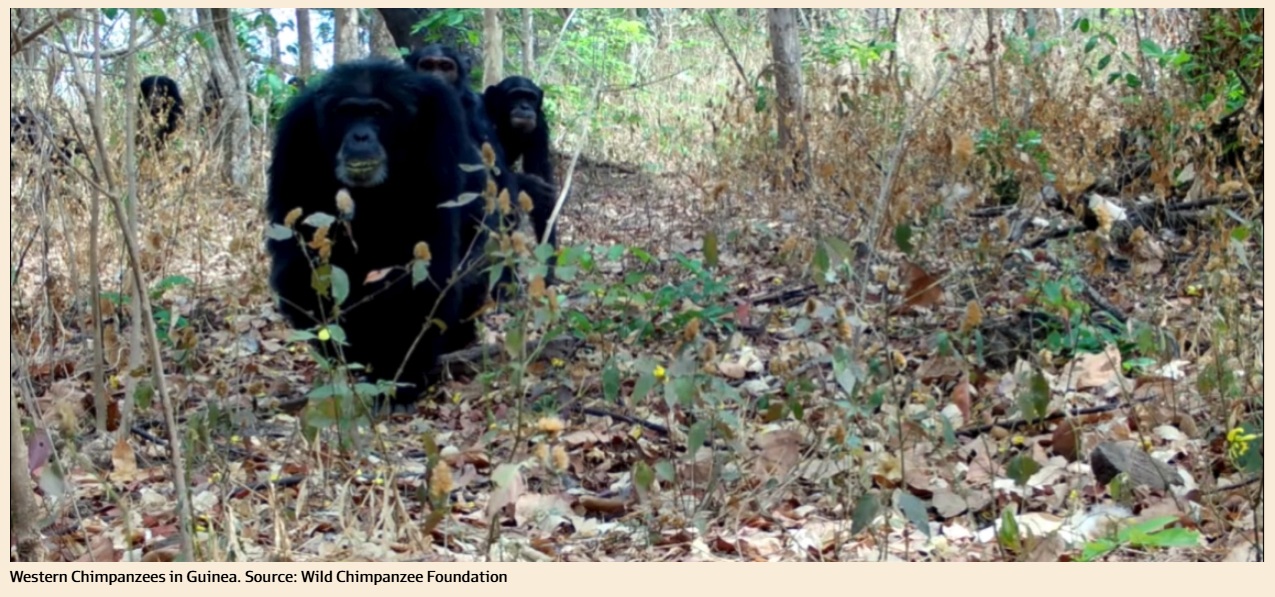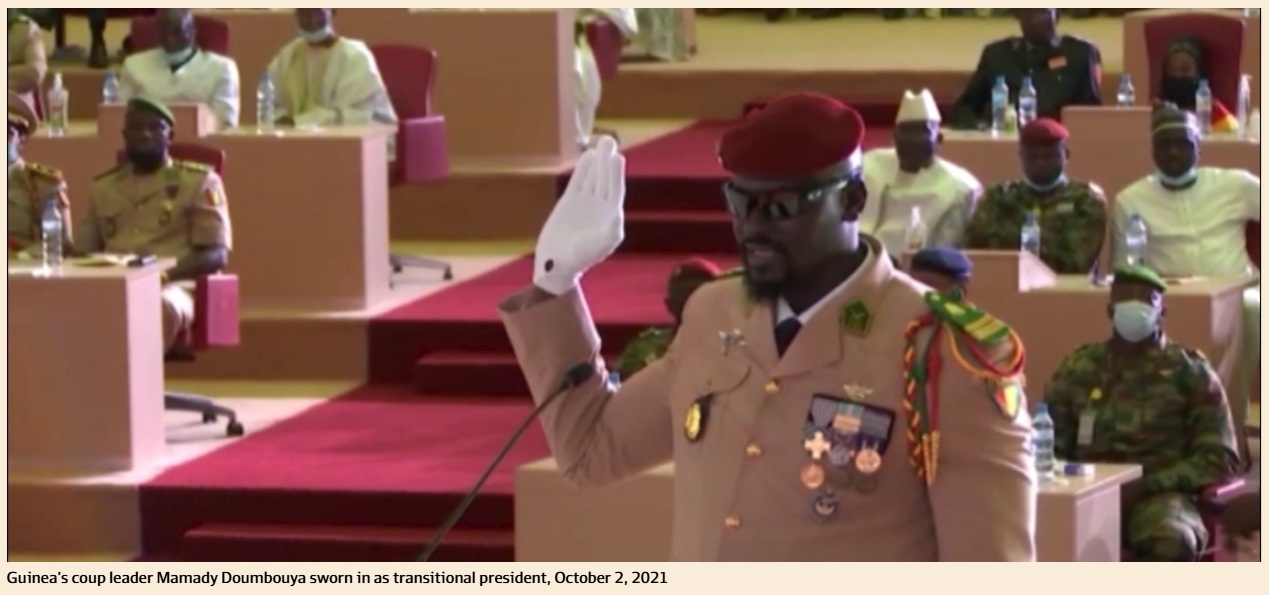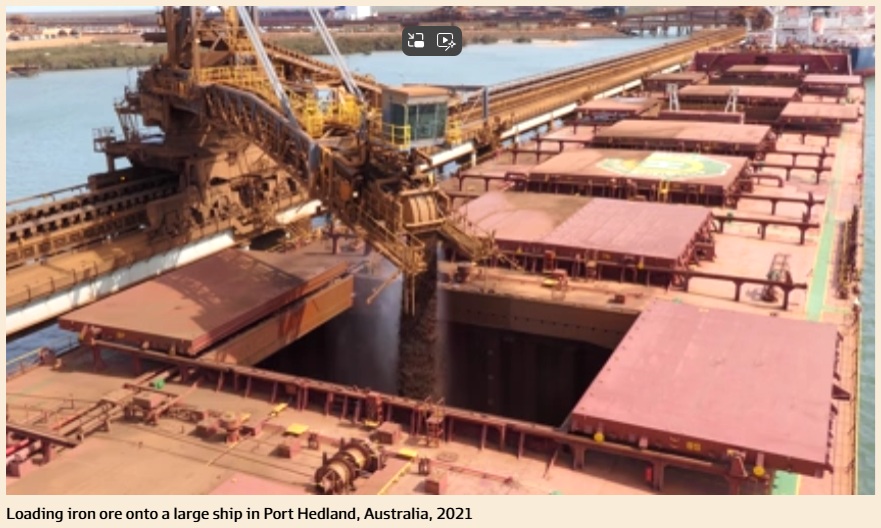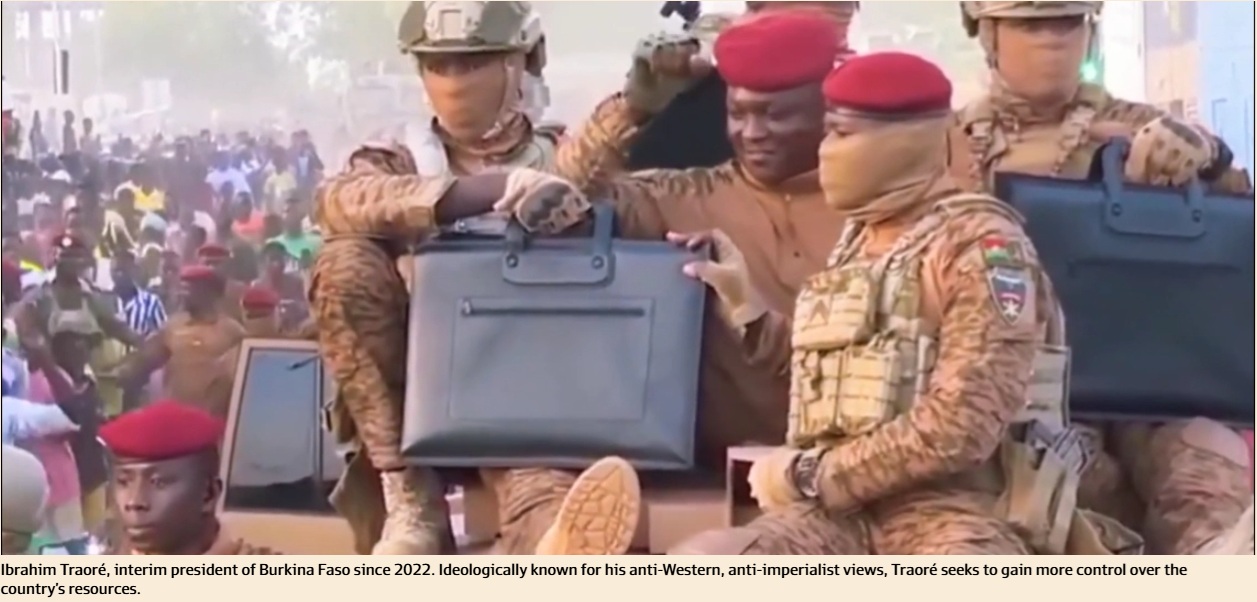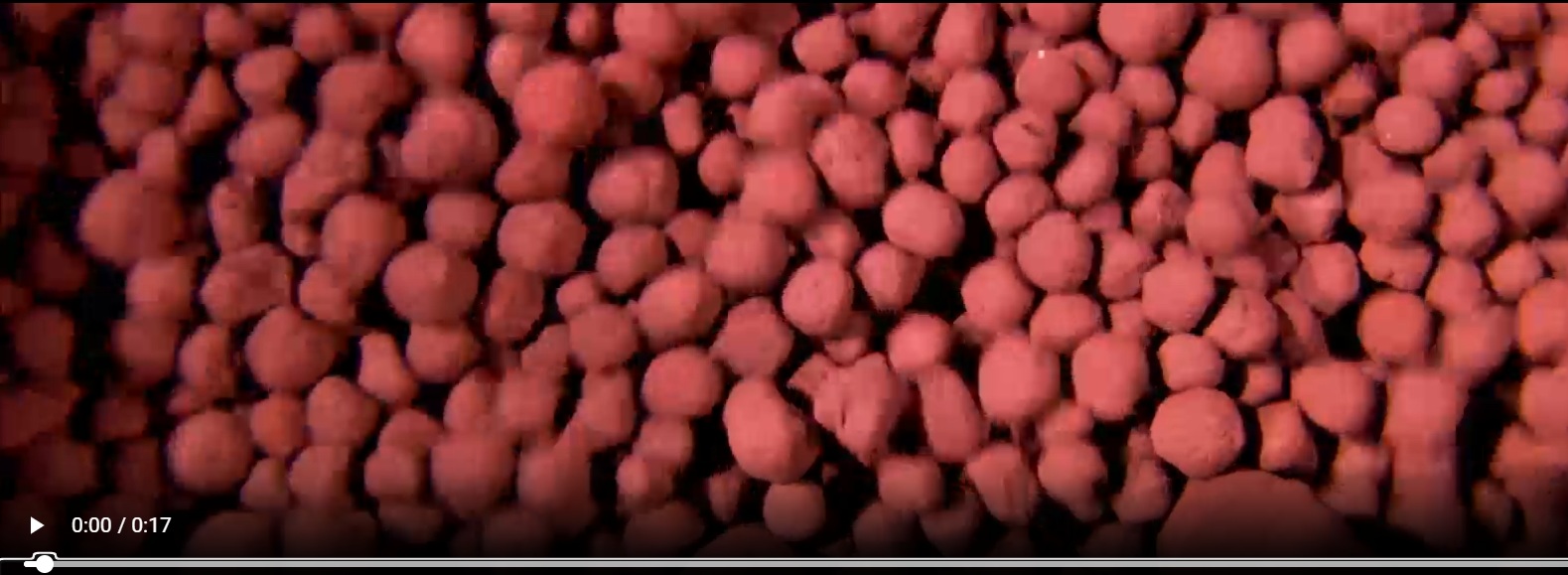Price History
Premium Content
Premium Content
Premium Content
Straws are discrete research notes that relate to a particular aspect of the company. Grouped under #hashtags, they are ranked by votes.
A good Straw offers a clear and concise perspective on the company and its prospects.
Please visit the forums tab for general discussion.
- Recent
- Votes
https://www.afr.com/interactive-freeview/2025/african-iron-ore/
That's a link to a recent AFR piece that does not appear to be behind a paywall that is very interesting for anybody directly exposed to WA Iron Ore (FMG, MIN, etc. and of course BHP & RIO).
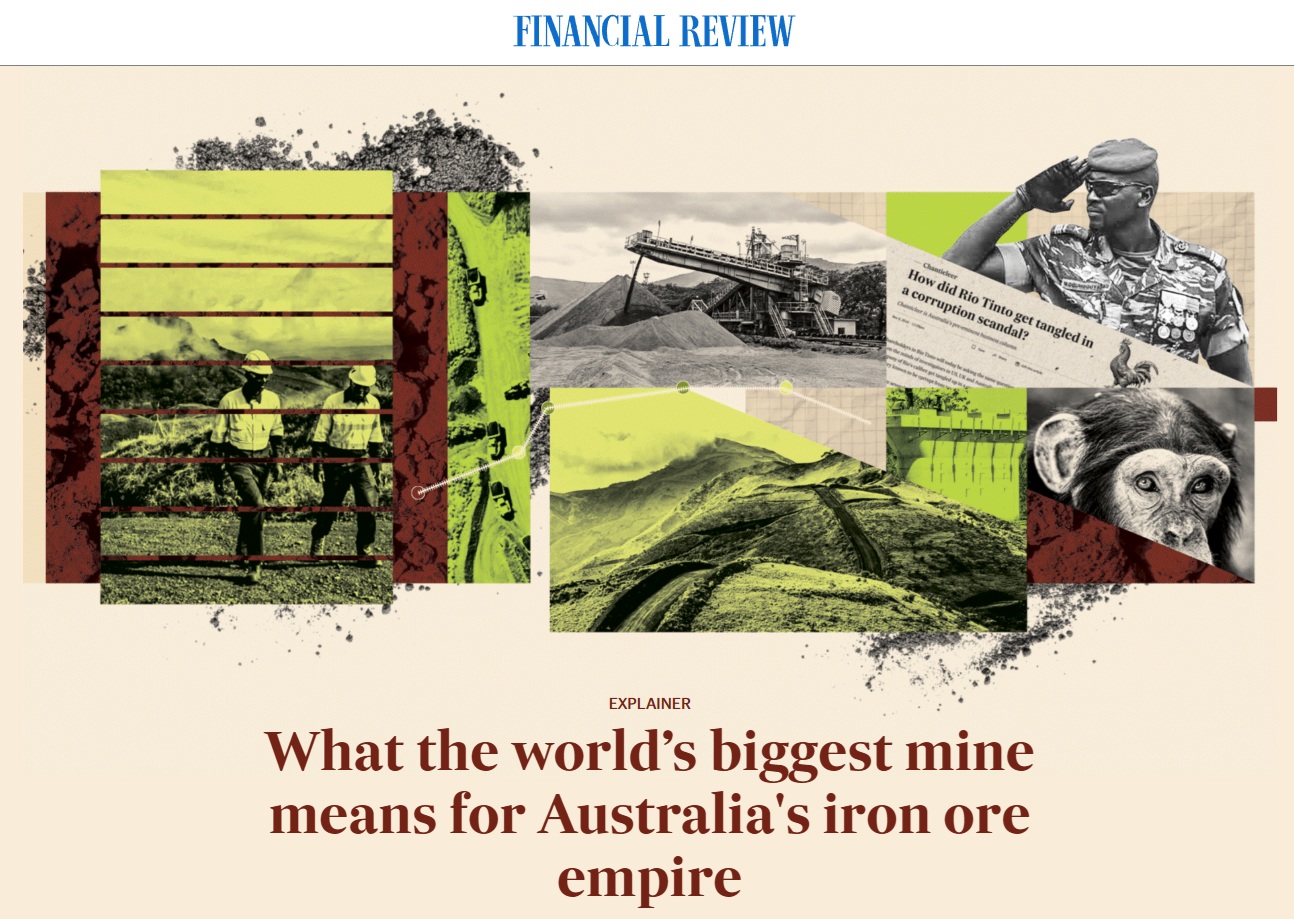
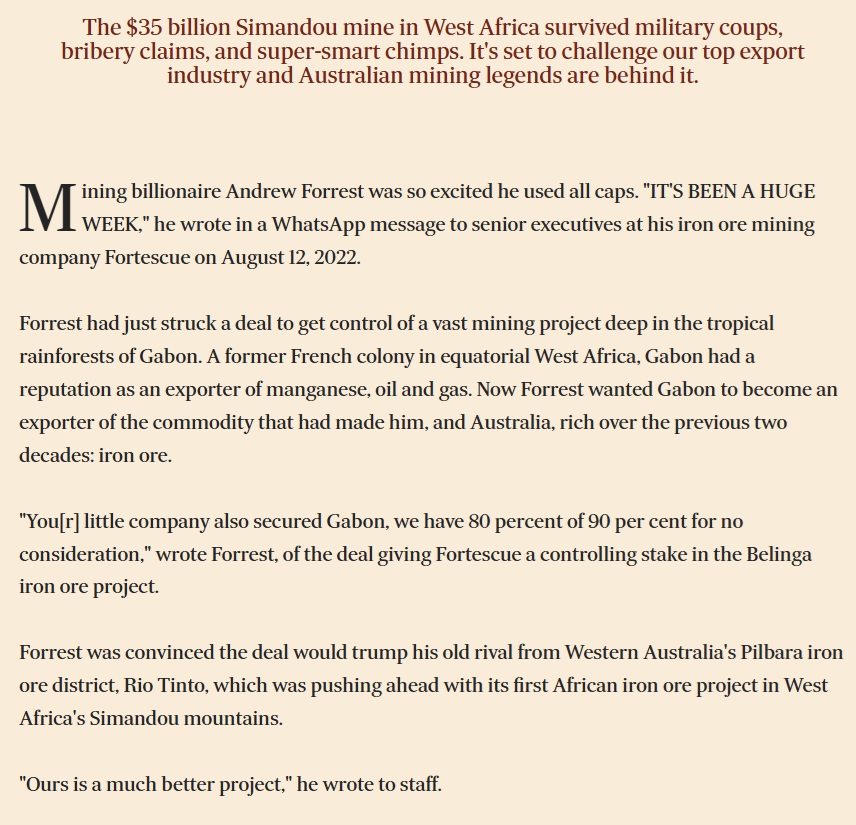
Three years on from Forrest's ebullient message, Rio is having the last laugh in the African iron ore war. Rio will start loading a boat with ore from Guinea's Simandou mountains in November. Unlike the single batch of Gabonese ore that Fortescue shipped in 2023, Rio's is expected to be the first of many, heralding the birth of a major new iron ore province.
When the first Simandou tonnes set sail from the port at Morebaya, it will be the culmination of a multi-decade journey that was buffeted by military coups, bribery allegations, project redesigns, commodity price gyrations, lawsuits that read like movie scripts and a campaign to save some super-intelligent chimpanzees.
The mines, railways and ports that will carry Simandou's ore to market will ultimately cost more than $35.5 billion. This is the world's biggest mining project under construction today, and it serves as a bellwether for the rise of Africa's long-stalled iron ore industry.
Export volumes from Africa are tipped to rise by 60 per cent between 2024 and 2027, and that's just the start of a trend that is as much about geopolitics as geology.
The wave of new mines is fresh competition for Australia's most lucrative export industry, adding substantial new supply at a time when Chinese iron ore import volumes are forecast to decline by 4 per cent.
Iron ore prices are tipped to fall by between 12 per cent and 30 per cent in the next five years, depending on which analyst you listen to. It's a trend that will punch a hole in Australian government tax receipts and GDP.
And in a perverse twist, many of those driving Africa's iron ore boom are the legends of the Australian industry.
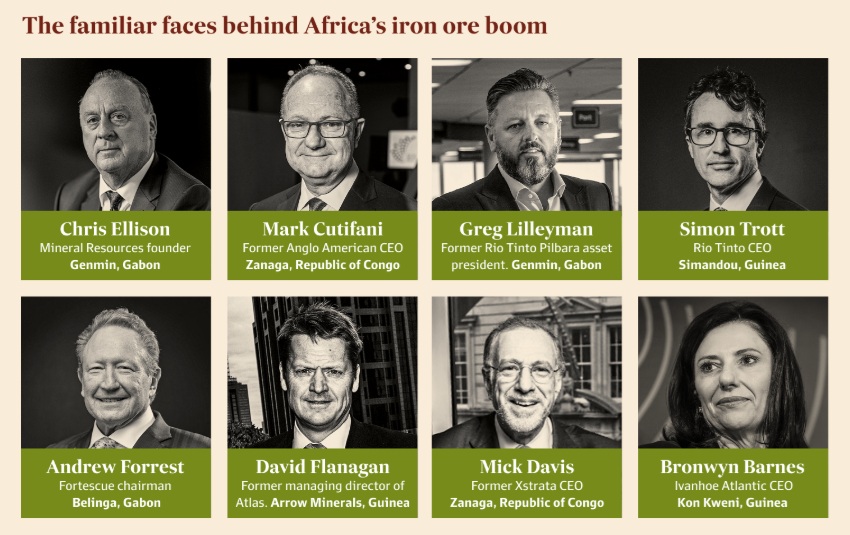
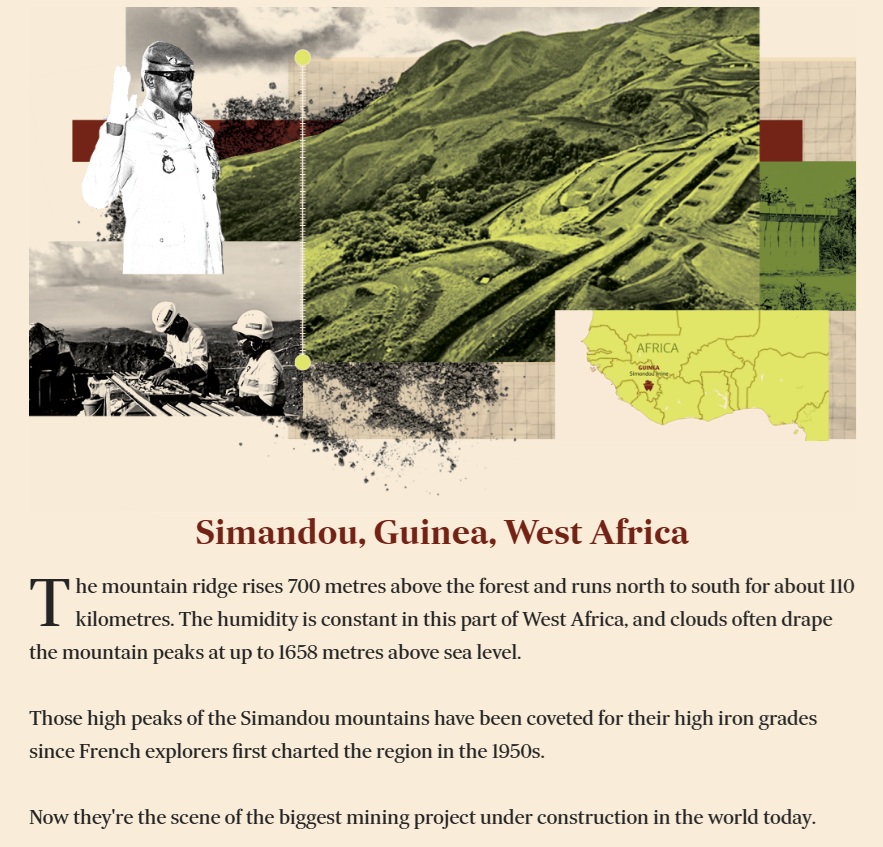
Click here or on the video above to watch the drone flyover footage.
Two rival consortiums – one led by Rio and the other led by Singaporean shipping company Winning International – are collectively spending $US23.2 billion ($35.5 billion) on the mines, railways, bridges and ports that will make the Simandou project a reality.
That sort of spend makes waves anywhere, but particularly in Guinea, which had gross domestic product of just $US15.4 billion last year according to World Bank data.
The tops of the mountains contain ore with between 64 per cent and 67 per cent iron; well above the grades shipped from Western Australia, where the ore typically contains between 55 per cent and 62 per cent iron.
But Simandou's superb quality ore could hardly be located in a more remote location, and building the railways, bridges and ports to carry the iron ore to customers abroad has always been hard and expensive. That's why Simandou was the mining industry's great white whale for decades.
"Iron ore is mostly about logistics, it always has been," says Perth-based Bronwyn Barnes, whose company Ivanhoe Atlantic is trying to develop a similar iron ore project about 200 kilometres away from Simandou.
Most of Simandou's $US23.2 billion is being spent on a 536-kilometre, transnational railway line that will connect the town of Kerouane in Guinea's south-east to a new port at Morebaya on the nation's west coast.
For the Guinean government, the transnational railway is hoped to become a "nation building" logistics corridor, that can stimulate development of other industries.
The two Simandou consortia are building rival mines that are about 100 kilometres apart.
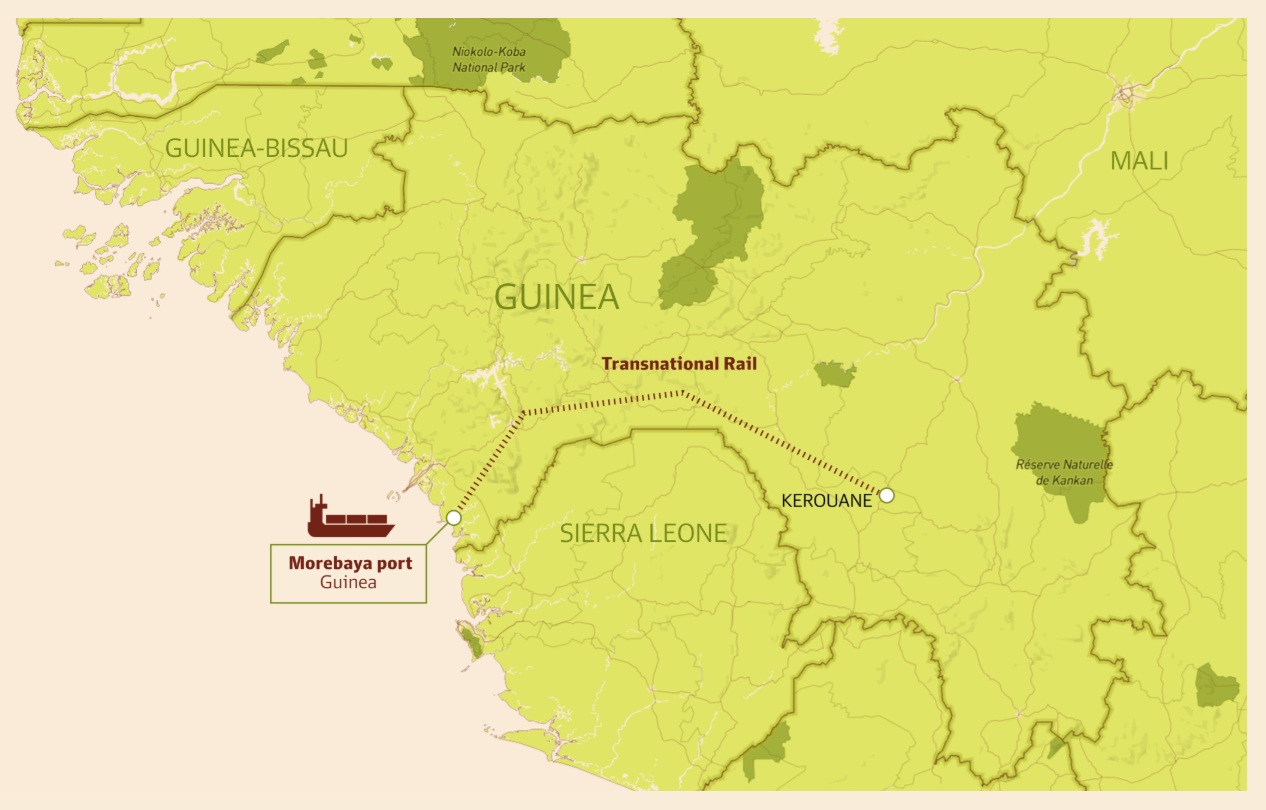
Both consortiums will use a 536 kilometre long transnational railway line to the port at Morebaya.
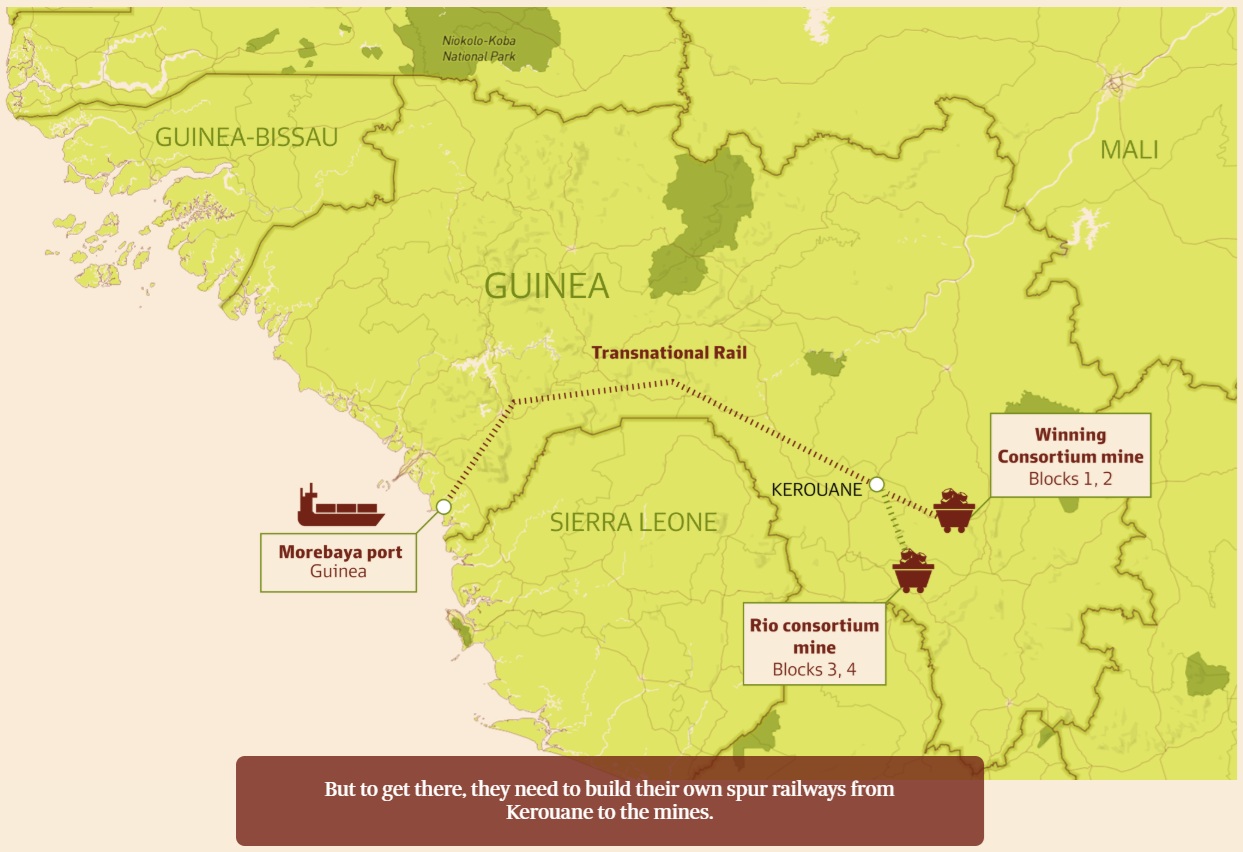
For the Rio mine, a railway spur of 78 kilometres will be required to connect to the transnational railway.
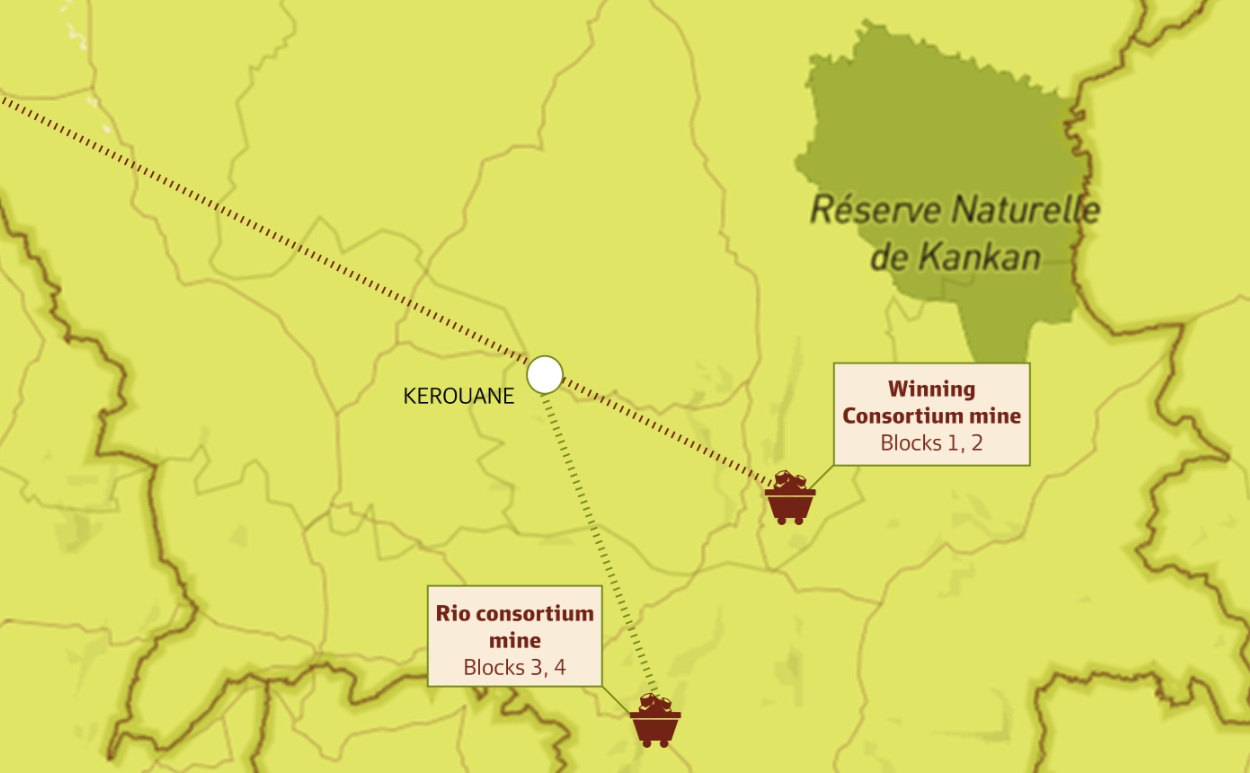
The easiest and most direct route for that spur would run along the western side of the mountain ridge.
But the Rio team spent hundreds of millions of dollars going through a much more difficult route. Why? Well, in short.. Because of some clever chimps.
The forest on the western side of the ridge is home to a community of Western Chimpanzees, a species ranked "critically endangered" by the International Union for Conservation of Nature. The chimps are exceptionally smart and are among the few primates that use tools to help themselves eat and drink.
Rio chief technical officer Mark Davies says expensive design changes were made to the spur railway to protect both the chimp habitat and Rio's reputation.
"When we designed the mine, the easiest thing to do was bring the rail straight into the western side and drive up and down the western side, but clearly that would be detrimental to that forest," he says.
The solution was to dig a 908-metre-long tunnel through the mountain range, so the railway could approach the mine on the eastern side of the ridge.
"That has cost us hundreds of millions, if not billions of dollars to address, but we have committed to those standards, and we have to live up to those standards," he says.
Click here or on the image above to watch the Chimp video.
Rio's Simandou mine will ramp up to produce 60 million tonnes a year within about 33 months, meaning it will be operating at full speed by about 2028 or 2029.
The neighbouring mine under development by the Winning consortium will also produce 60 million tonnes a year once ramped up, meaning the Morebaya port complex is forecast to export a combined total of 120 million tonnes per year by the end of this decade.
To put that in context, Australia is expected to ship about 905 million tonnes in 2025, making it easily the world's biggest exporter. Brazil will claim second place with about 424 million tonnes, while African miners will ship about 93 million tonnes.
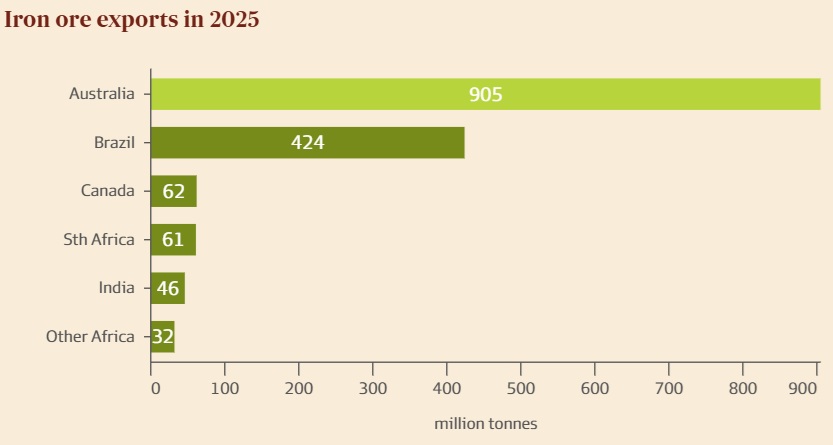
Australian miners have traditionally feared that if railways and ports were ever connected to the Simandou mountains, the province could be rapidly expanded and challenge the Pilbara's stranglehold on global supply. Previous plans for the province talked of producing 170 million tonnes per year.
But most analysts are sceptical about the potential for Simandou to reach the modern-day target of 120 million tonnes a year, let alone be expanded further. CRU Group iron ore analyst Liz Gao says a long and complex supply chain and extreme weather patterns will cap output.
"Once fully ramped up, Simandou is likely to deliver just over 100 million tonnes per year," she says.
Compared to previous plans to develop Simandou, the size of the railway equipment adopted this time is much smaller and cheaper.
Axle loads on Rio's Simandou spur railway will be 25 tonnes; well below the 42 tonne axle loads on some of the trains that carry Australian iron ore to port.
Lower axle loads will limit the Simandou partners' ability to expand production in future.
The same is true at the port.
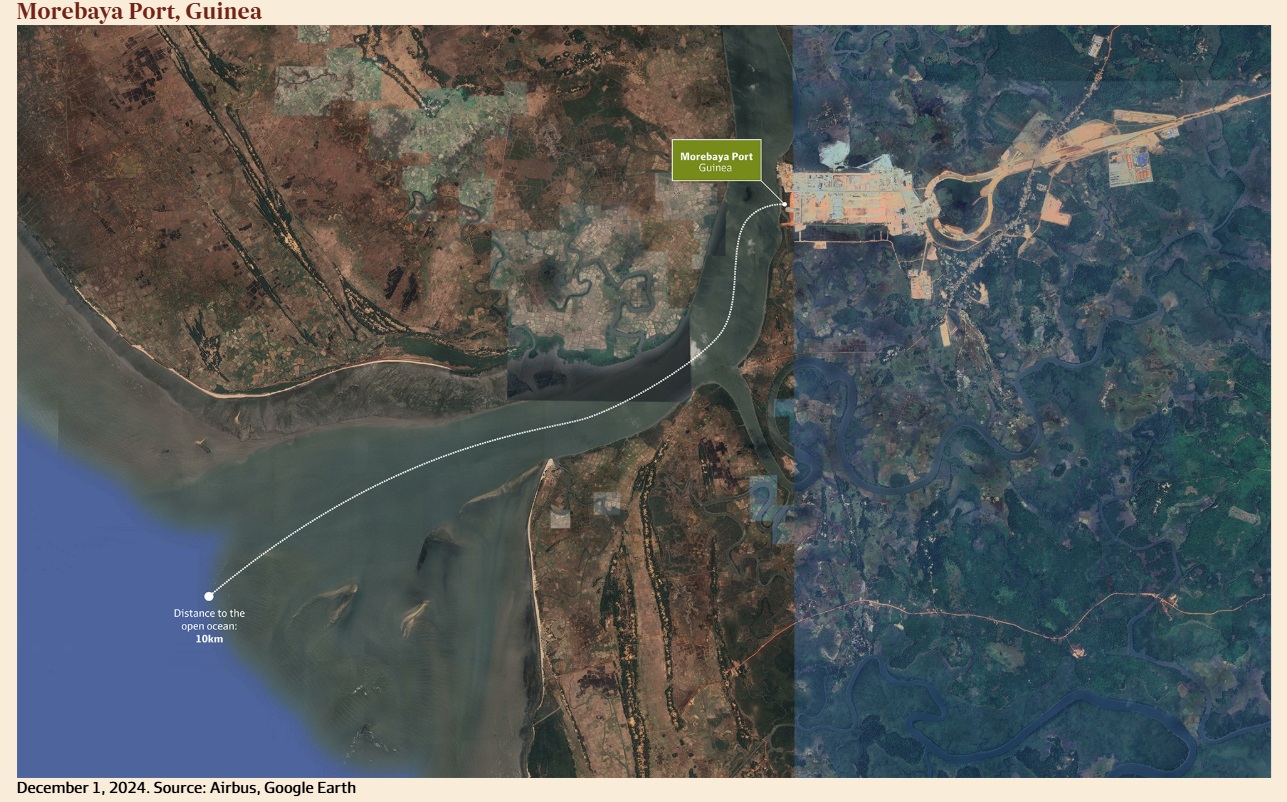
Rather than a deep-water port on the coast, Morebaya port is built on a narrow, estuarine river.
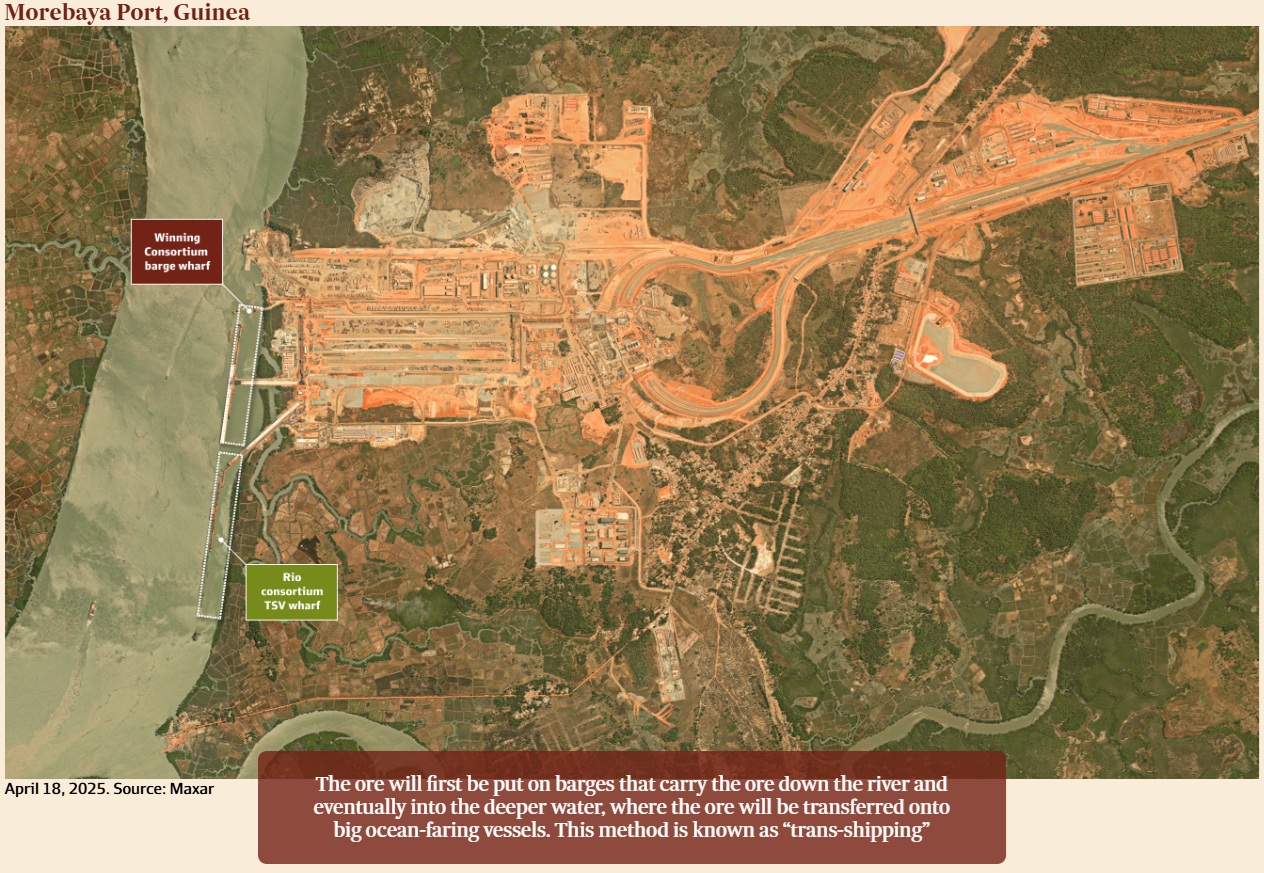
A trans-shipping operation like Morebaya is cheaper to build than a big deepwater port like Port Hedland in Western Australia, where conveyor belts stand on the wharf and pour a continuous stream of ore into the bellies of big "capesize" vessels.
But trans-shipping is less efficient once operations begin because every tonne of ore needs to be double-handled. It is also less scalable because there is a limit on the amount of ore that can be barged down a narrow river.
"The trans-shipping becomes the bottleneck," says Macquarie analyst Rob Stein, when asked about the potential for Simandou volumes to be expanded.
"We think that Simandou will hit 110 million tonnes per year by 2030, with creep to 115 million tonnes taking a few extra years."
The Simandou infrastructure has been built quickly by international standards, with Chinese engineering and construction firms winning plaudits for their cookie-cutter approach to building bridges and other items.
Rio chief Simon Trott describes it as "catalogue engineering" and a big change from the way Rio has traditionally built things in Australia.
"There's 30 or 40 river crossings. We would go to each one of those river crossings traditionally and design the perfect bridge, get the configuration right. They've got a long bridge, a short one and a medium one, and it is just rolling it out and replicating," he told investors in London in October.
The trade-off for the speed and efficiency of the Chinese engineering might be safety. Reuters reported earlier this year that 13 people had been killed on the construction project between 2023 and early 2025.
When Guinean president Alpha Condé was overthrown by a military coup in September 2021, it presented an ethical dilemma for Rio and the other western companies that work in the country.
Click here to watch the video.
Could it meet the governance standards of their first world stakeholders if they continued to work under an administration that was governed by an unelected dictator brandishing a gun?
The answer Rio found on its subsequent visits to Washington and Westminster was yes; Western governments were eager for Rio to persist in Guinea to ensure the project's infrastructure did not become entirely Chinese-controlled.
That sort of statecraft is commonplace in Africa nowadays, with the US government pumping money into projects like the Lobito Corridor, which will provide critical minerals producers in the Democratic Republic of Congo and Zambia with a rail connection to the port of Lobito in Angola.
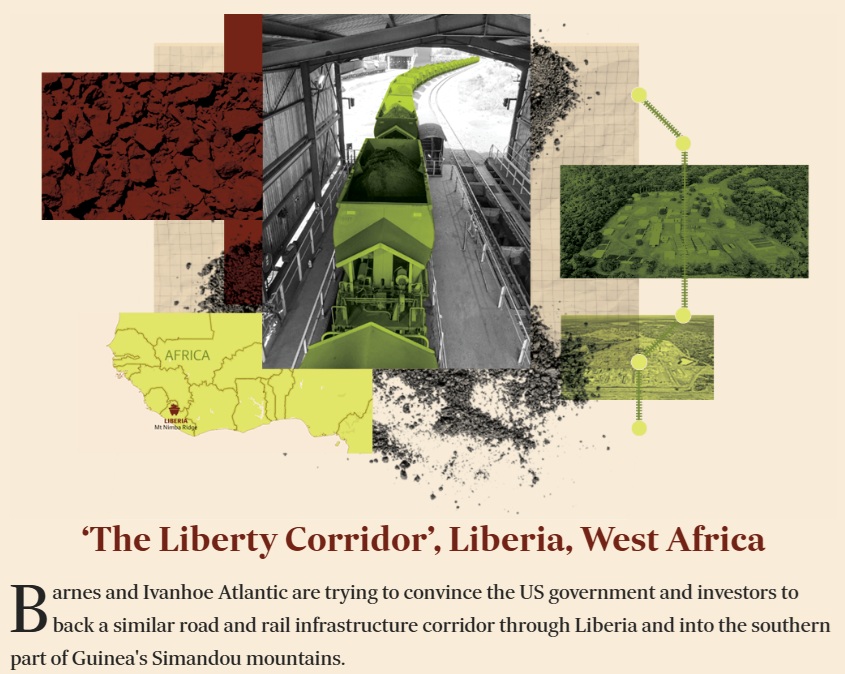
Dubbed the "Liberty Corridor", it would be shorter than Simandou's transnational railway at about 300 kilometres, and would carry iron ore to port from Ivanhoe's proposed Kon Kweni mine in Guinea.
"We are trying to pull together a consortium that would fund the Liberty Corridor and that is a large part of the discussion we are having with the US," says Barnes.
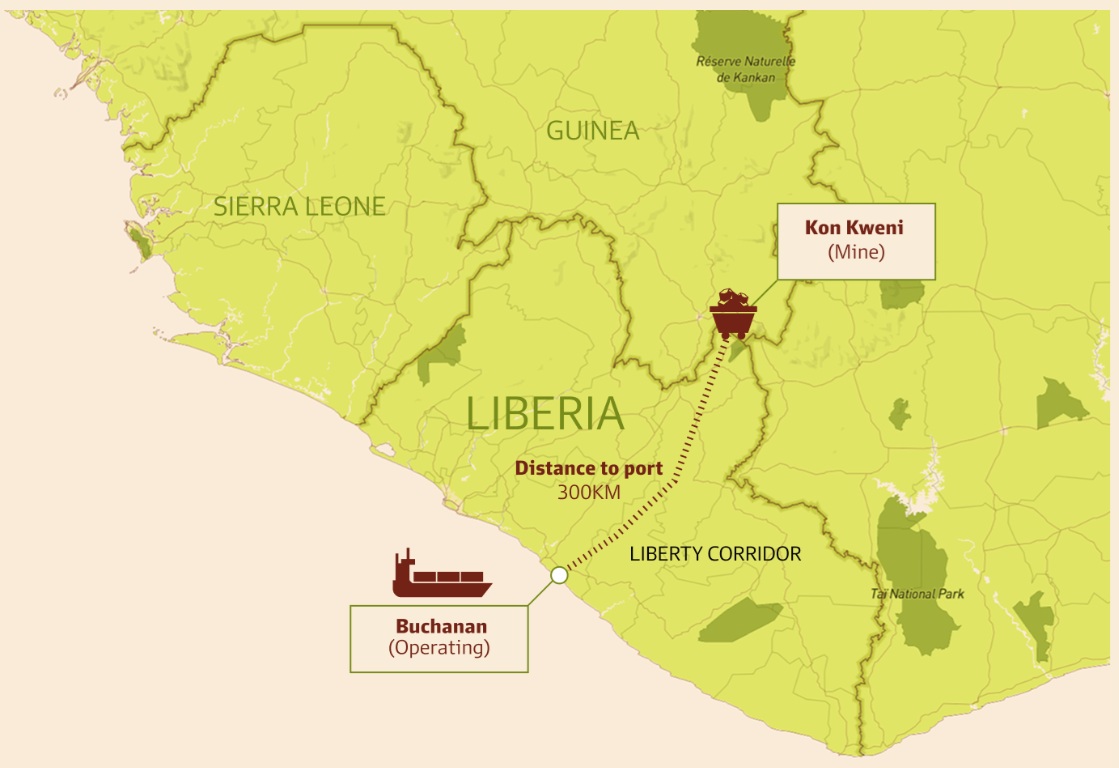
‘This is the US response to China's Belt and Road. Now they've worked out the importance of being involved in infrastructure corridors in Africa, I think there is a real appetite for them to step up their involvement.’
"It is not just iron ore that sits within trucking distance of that Liberty Corridor, there are also other critical minerals."
Ivanhoe hopes to initially produce 2 million tonnes of ore each year at Kon Kweni, before ramping up to 5 million tonnes per year. The resource is big enough to sustain a 30 million tonnes a year mine, should market conditions warrant it.
Ivanhoe's iron ore won't be the first to leave Liberia; multinational steel giant ArcelorMittal started mining at Tokadeh in 2011 and has spent close to $US3 billion expanding the mine to an annual capacity of 20 million tonnes.
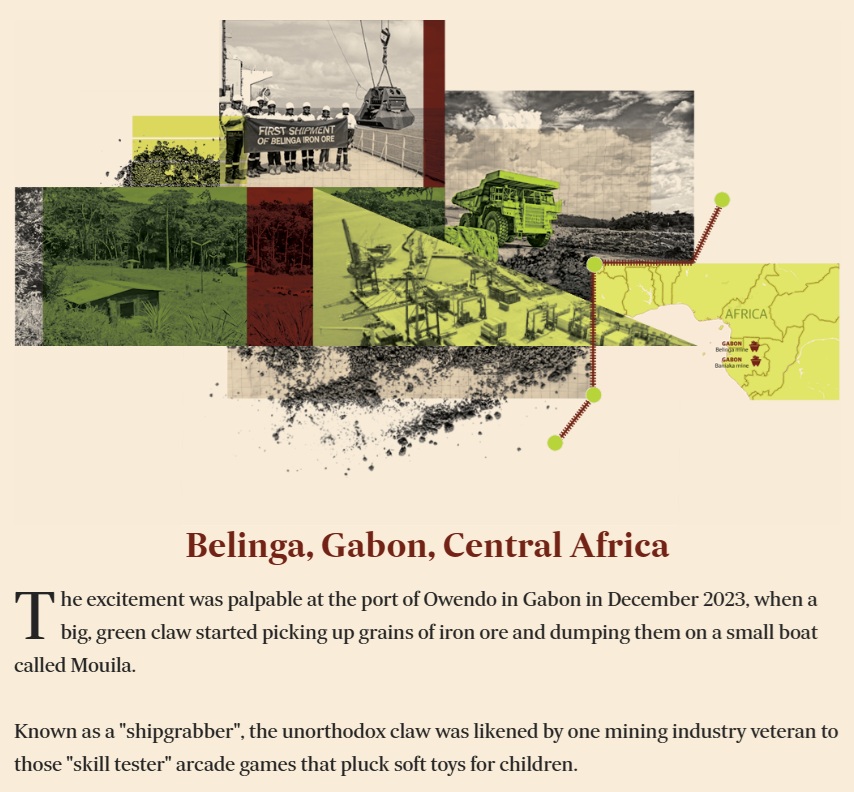
It was certainly a far cry from the giant shiploaders that pour a continuous stream of Fortescue's Australian ore deep into the bellies of the much bigger ships that dock at Port Hedland.
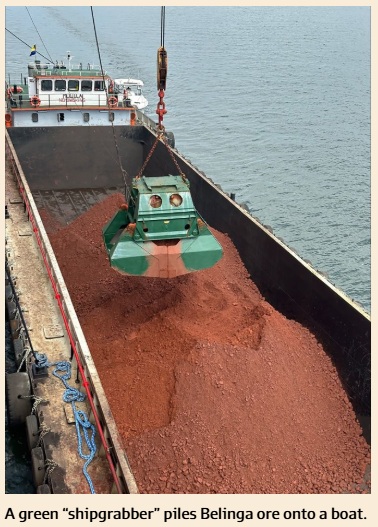
Click on the image above to see the 20 second video/GIF of iron ore loading at Port Hedland.
But for Fortescue Mining chief executive Dino Otranto, this was a revolutionary moment. The ore had come from the Belinga iron ore deposit; a mountain range located 550 kilometres away in one of Gabon's tall canopy forests.
Like Simandou, Belinga's high-grade ore had for decades been stranded because of the high cost of building railways and ports to get the ore to market.
But in typical style, Fortescue sought to crash through those impediments by sending a small batch of ore to port on the back of a truck, barely 11 months after striking a mining convention with the Gabonese government.
Otranto was at Owendo as the big claw piled 11,000 tonnes of ore onto Mouila; about 23 times less ore than gets piled onto the big capesize vessels at Port Hedland.
Despite the small volumes, Otranto insisted the shipment was big on symbolism.
"This project has the potential to revolutionise our portfolio and ultimately create a product that will be the envy of our peers. It will also open growth opportunities for Fortescue throughout Africa," Otranto claimed on December 5, 2023.
But three months later, Otranto confirmed the first shipment of Belinga ore was mostly for show.
"The shipment, I wouldn't read too much into that," he told analysts on an earnings call on February 22, 2024.
"That was very, very early days and the concept was to prove the logistics process and also to demonstrate to our stakeholders here … how serious are we as a partner.
"This orebody has been around since the 1960s and no one's been able to get any ore out, and we did it in about six months. However, we won't be ramping up that particular supply chain through the road network here."
Since then, mining has ceased at Belinga.
Click on the image above to watch the 9 second zoom out.
In October 2024, Fortescue terminated the five-year, $US150 million, Belinga mining services contract it had issued to Capital Limited just 16 months earlier.
Fortescue has spent the past year doing little more than exploration drilling at the site and working on a feasibility study.
Otranto says work on a feasibility study for Belinga will continue until December 2026. Just as it was for Simandou, the biggest issue for the Belinga feasibility study will be railways and ports.
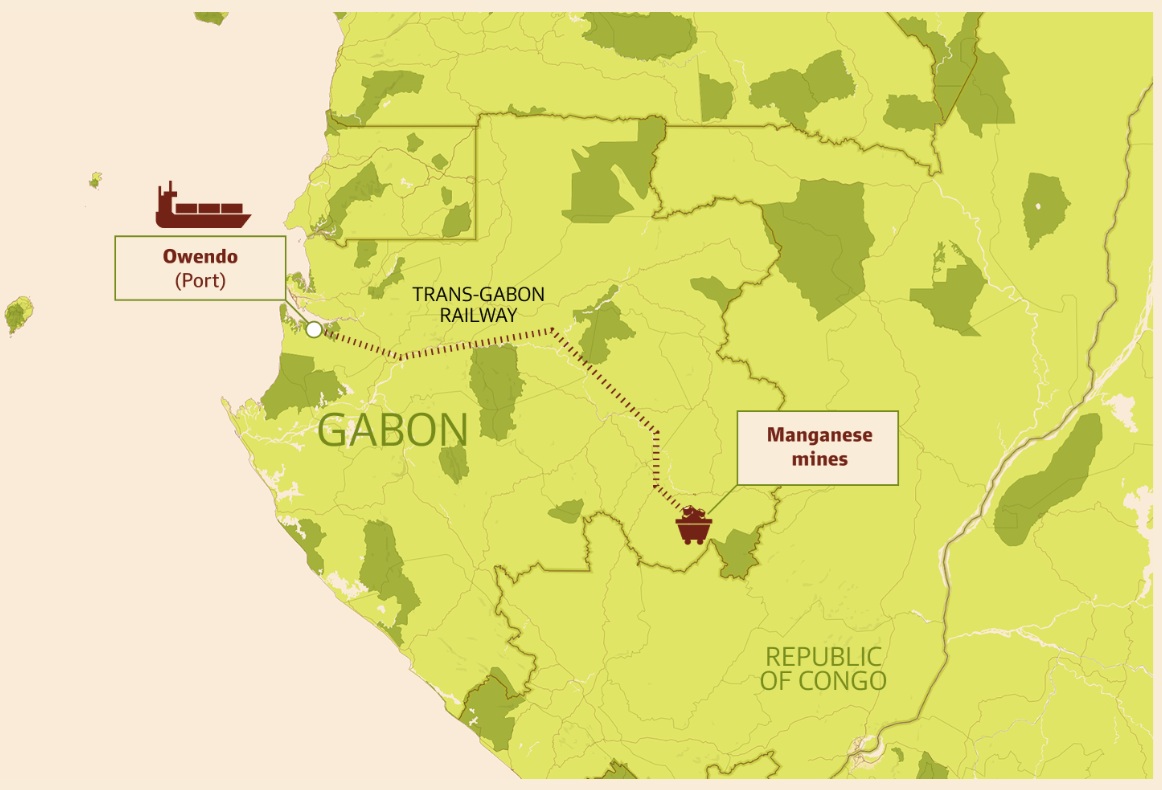
Gabon already has a 669 kilometre transnational railway that carries manganese ore and other commodities to Owendo port.
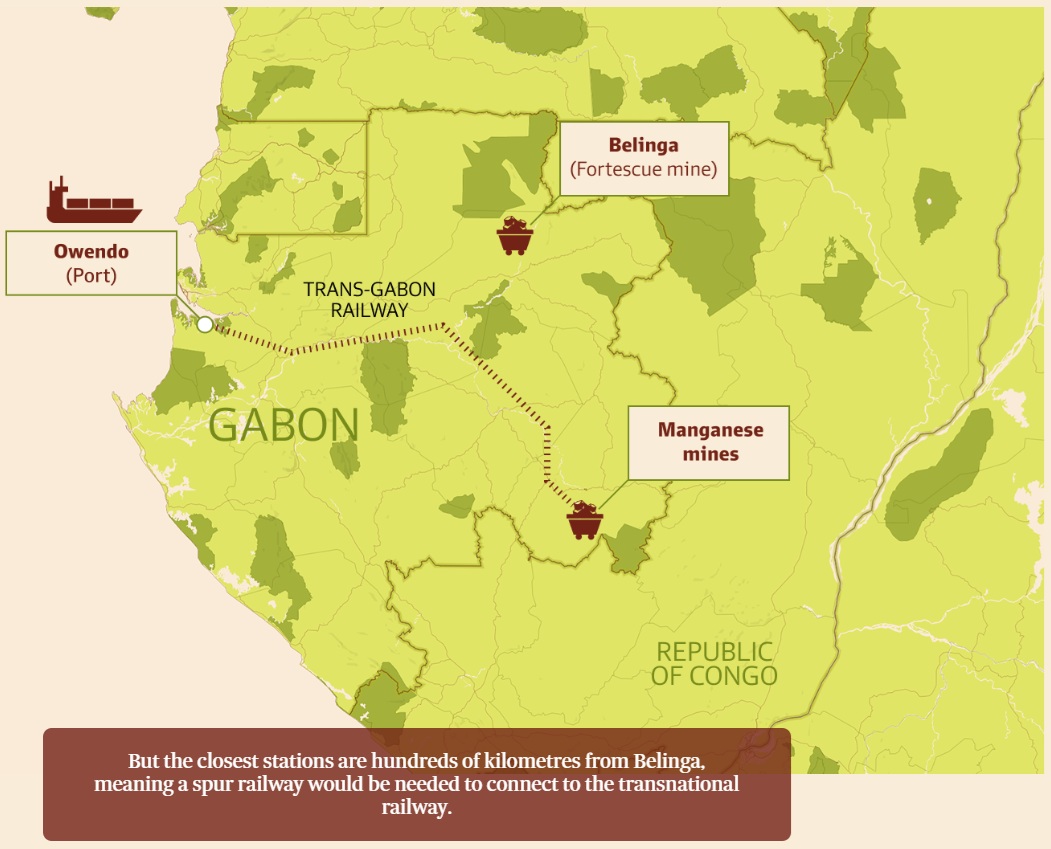
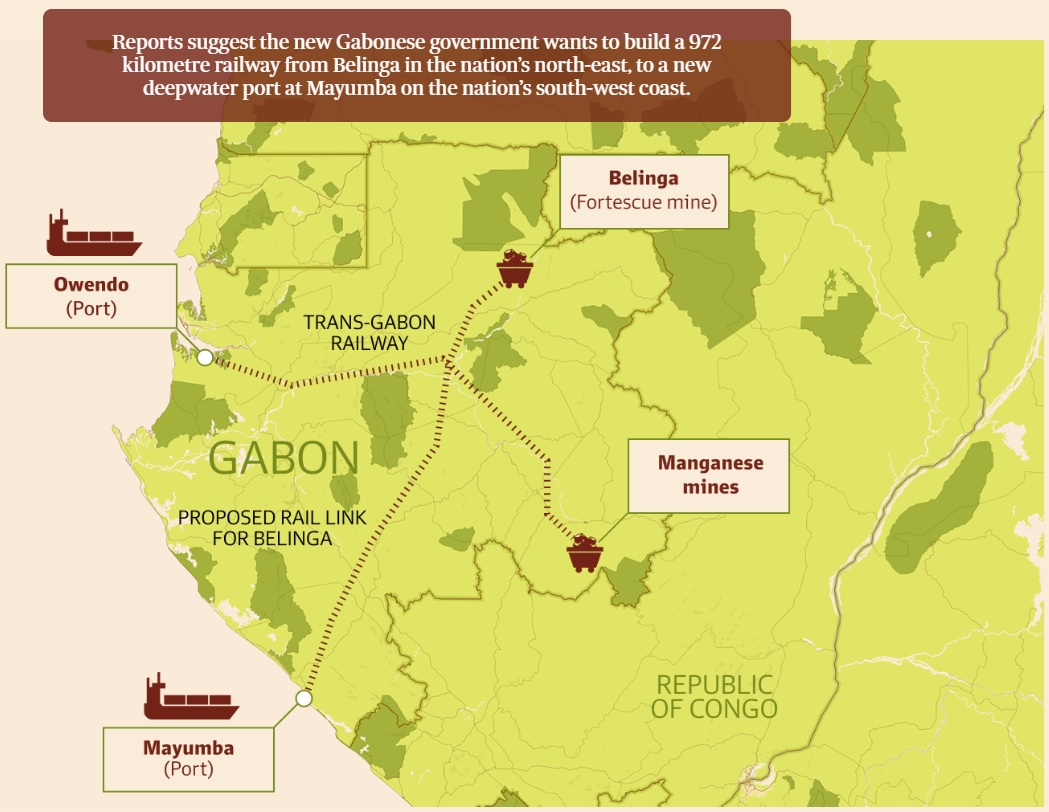
The cost of the project has been touted at close to $US10 billion, and it's unclear who would pay for it.
JP Morgan doesn't give Fortescue much chance of building a mine at Belinga: the investment bank values Fortescue's stake in Belinga at zero.
At the current rates, Fortescue's former chief operating officer Greg Lilleyman might be shipping Gabonese iron ore before his former employer ships the second batch from Belinga.
Lilleyman is chairman of Genmin; a small ASX-listed company with an $18 million market capitalisation that hopes to develop the Baniaka iron ore deposit in Gabon's south.
Baniaka has ore with 63 per cent to 64 per cent iron, which can be trucked a relatively short distance to reach Gabon's transnational railway.
At a cost of $US200 million, Genmin hopes to build a mine producing 5 million tonnes a year and the resource is large enough to host a mine producing 20 million tonnes a year.
At those small initial volumes, Genmin can more easily fit in with the limited capacity on the transnational railway.
"There is existing power, rail to port solution within a 50-kilometre distance from our deposits," he says.
If Genmin can get Baniaka into production, the winners will include Mineral Resources managing director Chris Ellison, who is a shareholder in Genmin in his private capacity.
The many risks of mining in Africa
A series of coups d'etat have rocked Australian miners working in Africa in recent years. Madagascar became the latest example on October 14, when a section of the military seized power of an island that is home to some Rio Tinto mineral sands mines.
Leaders in Gabon and Guinea have also been overthrown by armed but peaceful militia in the past four years.
In the past five years Australian companies like AVZ Minerals, Equatorial Resources and Sundance Resources lost control of lithium and iron ore projects in either the Republic of Congo or the Democratic Republic of Congo in circumstances that were murky. Arbitration via World Bank tribunals have followed.
Perth-based gold miner West African Resources got a shock in late August when the Burkina Faso government declared it was suddenly taking an extra 35 per cent stake in WAF's Kiaka gold mine.
Click on image above to watch the 7-second video grab.
Things have been even murkier in Mali, where ASX-listed Resolute Gold had its chief executive Terry Holohan and other employees detained in November 2024 over a tax dispute.
"There is still a heightened level of sovereign risk in African nations, no doubt," says Lilleyman.
"Africa isn't one country. There are numerous countries with different levels of sovereign risk."
Former Atlas Iron chief executive David Flanagan saw the difficult side of African mining this year, when media reports in Guinea declared his new vehicle Arrow Minerals had two of its tenements cancelled.
One of the tenements is named "Simandou North", and is hoped to produce iron ore that gets put on the same trains that carry ore from the Rio and Winning mines nearby.
Arrow shares have been suspended for the past five months, as Flanagan and the Arrow team have tried to clarify the status of their tenements with the Guinean government.
There has been no shortage of sovereign risk for Rio at Simandou over the years.
The company originally controlled all four mining tenements in the Simandou mountains, but the Guinean government confiscated half of the acreage in December 2008 and awarded it to Israeli diamond magnate Beny Steinmetz.
A Swiss court would later convict Steinmetz of bribing foreign officials to obtain the Simandou acreage.
In 2014, Rio filed a spectacular lawsuit in a US court, which accused the world's biggest iron ore miner - Brazilian giant Vale - of conspiring with Steinmetz to strip Rio of the Simandou leases.
Rio and Vale spent much of 2008 in secret talks over a deal that would have seen Rio sell a portion of its four Simandou tenements to Vale.
In documents filed to the US District Court for the Southern District of New York, Rio accused Vale of entering those talks with fraudulent intent.
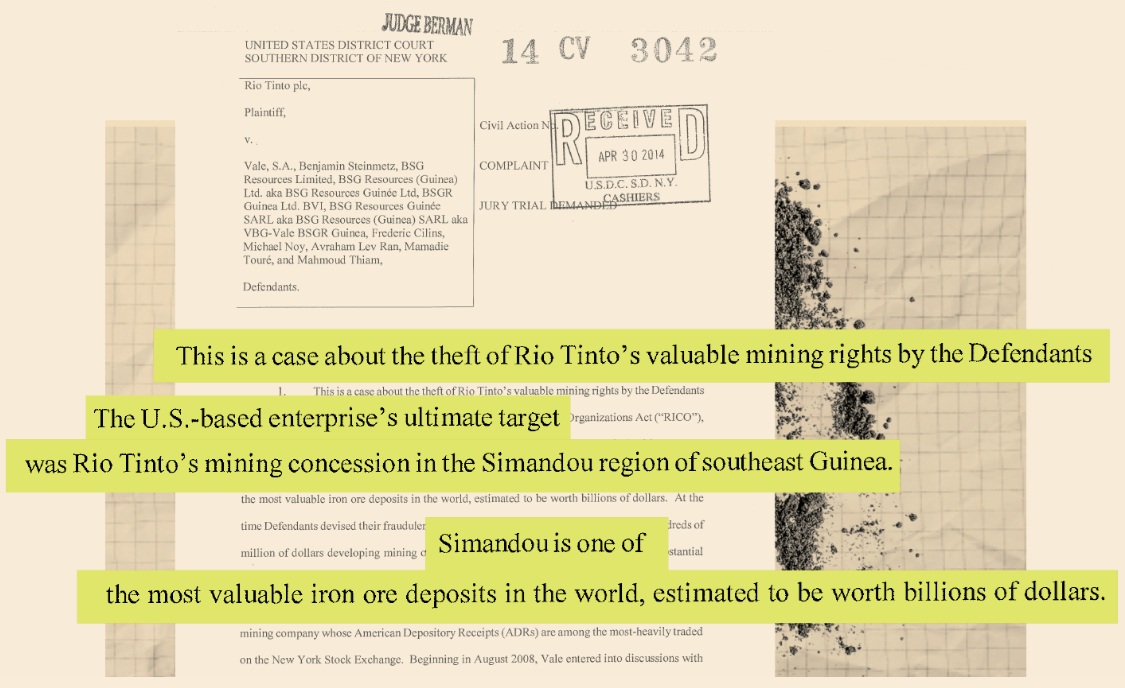
With its claims of racketeering, theft, conspiracy and corruption, Rio's lawsuit read like a movie script. But by November 2015 it had been dismissed because the alleged events had occurred beyond the statute of limitations.
The following year in 2016, the spotlight would turn to Rio's dealings in Guinea, when a series of leaked emails sparked a reputational crisis for Rio.
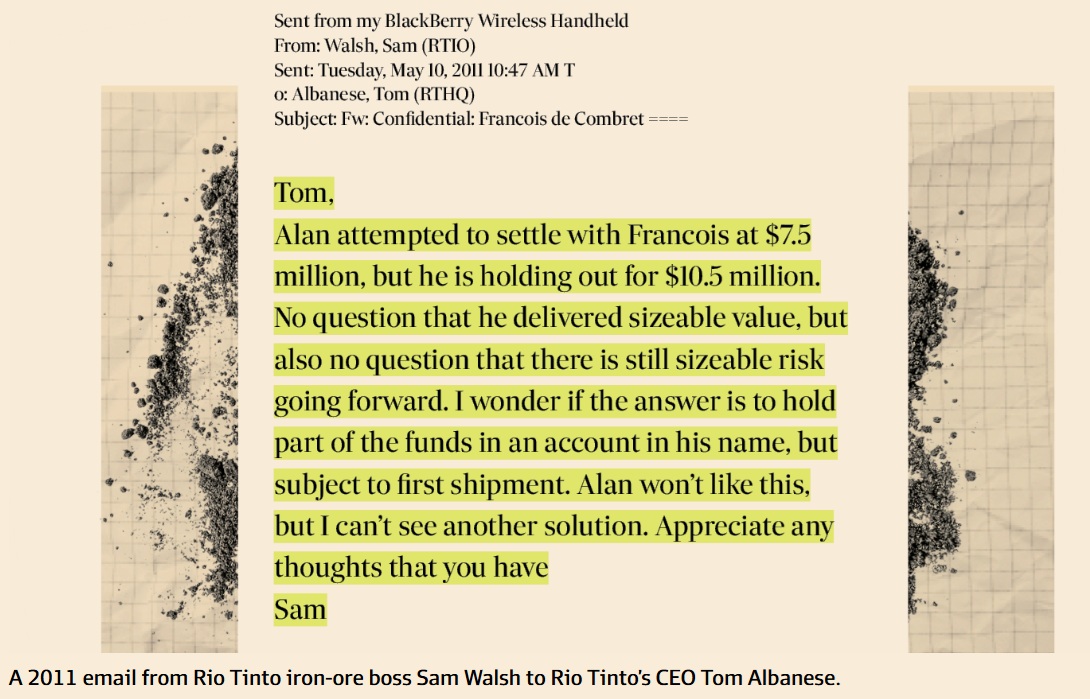
The leaked emails were from 2011, and showed Rio executives discussing a $US10.5 million payment to a political consultant named Francois Polge de Combret, whose close relationship with then Guinean President Conde helped ensure Rio kept possession of half the Simandou tenements.
The leaked emails triggered the termination of three Rio executives and corruption investigations in the US, UK and Australia.
To this day, the Australian Federal Police have a live investigation underway into the 2011 payments. De Combret will never see the result of the AFP investigation; he died on October 8.
Will African iron ore break Australia's stranglehold?
Australia will ship about 905 million tonnes of ore this year, well above the 93 million tonnes that are expected to leave Africa.
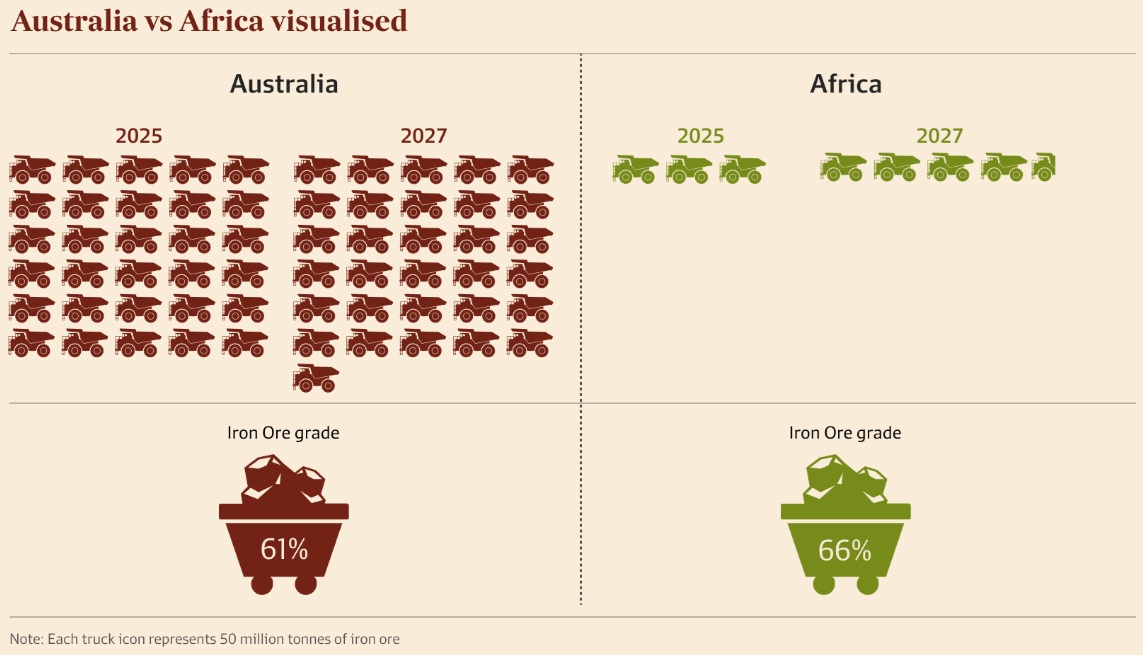
But by 2027, the Department of Industry expects African iron ore exports to rise to 140 million tonnes.
The volume growth will come from a list of nations that includes Guinea, Liberia, Mauritania, Sierra Leone, Morocco, Algeria and Kenya. The department expects those nations to grow exports to 87 million tonnes in 2027, up from 27 million tonnes in 2024.
For comparison, Australian miners are tipped to grow volumes by 30 million tonnes between 2024 and 2027.
Extra supply always weighs on commodity prices, and the downward pressure could be doubly strong if demand from steelmakers fades at the same time as African miners ramp up volumes.
British investment bank Panmure Liberum believes global demand for finished steel will peak this year at 1.9 billion tonnes then fall in each of the next four years to reach 1.788 billion tonnes by 2029.
Panmure Liberum believes iron ore prices will slide to average between $US68 and $US71 a tonne (including the cost of shipping to China) in each of the next five years.
That's well below the $US107 a tonne seen in October, and Panmure's forecast would push some marginal Australian mines into mothballs.
Every $US10 fall in the average iron ore price for the year ahead will put a $500 million hole in federal tax receipts and decrease Australia's nominal gross domestic product (GDP) by $2.5 billion.
The new African mines will have one clear advantage over their Australian rivals; they will generally produce ore with higher iron content, which fetches higher prices.
Most ore shipped from WA contains between 55 per cent and 61 per cent iron.
But GenMin's Gabonese ore will contain between 63 and 66 per cent iron, Simandou ore will contain about 65 per cent iron, while Ivanhoe Atlantic's initial volumes will be ore with a staggering 67.5 per cent iron.
When Panmure Liberum forecast an iron ore price of $US68 a tonne later this decade, it was referring to ore with 62 per cent iron.
Higher prices will be paid for ore with more than 62 per cent iron and that gives Ivanhoe chief Barnes confidence her $US120 million Kon Kweni mine can be viable even if "benchmark" prices slide.
"We are very comfortable that the iron ore price will hold particularly for the high grade," she says.
CRU Group's Gao doesn't expect African mines to cut Australia's lunch; by 2030 she expects Africa will have 10 per cent market share.
"There are lots of projects in Africa, but we think it will be challenging to bring them all to the market. High transportation and infrastructure costs, geopolitical uncertainty, and restricted power supply will remain key constraints in bringing African iron ore to the seaborne market," she says.
"The cash costs of operations like Simandou are likely to sit in the third quartile of the [cost] curve, while the Australian majors will continue to dominate the first and second quartiles."
Gao says Simandou will largely replace retiring mines and result in only a "small net addition to the seaborne iron ore market".
Even if the wave of new supply from Africa drove iron ore prices down to $US68 a tonne, the Australian mines of Rio, BHP and Fortescue would still be profitable.
The cost of shipping ore from West Africa to China is expected to be three times the cost of shipping from the Pilbara to China.
"The one fact of life that cannot be changed in the iron ore business globally is you can't move Brazil nor West Africa closer to China. Australia will have the same shipping advantage over African miners as it has had over Brazilian miners," says Clinton Dines, who served as BHP's China president between 1998 and 2009.
Dines is now a director of London-listed Zanaga Iron Ore, which hopes to develop a $US1.94 billion mine in the Republic of Congo. Zanaga's investors include former Anglo American chief Mark Cutifani, former Xstrata boss Mick Davis and Rio's former head of business development and strategy, Phil Mitchell.
Dines reckons the rise of the African iron ore industry is not something Australia "needs to panic about", even if it drives down prices for the commodity.
"BHP and Rio are going to be profitably selling Australian iron ore for a very, very long time," he says.
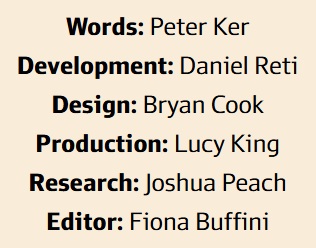
Source: https://www.afr.com/interactive-freeview/2025/african-iron-ore/
Bear77 disclosure: Not holding FMG, MIN, BHP or RIO currently. I do have a position in RHI (Red Hill Minerals, in my speccy stock portfolio only) who have some iron ore and gold projects and interests, mostly in WA's Pilbara region, as well as a few royalties including one royalty that covers all of the iron ore that MinRes (MIN) mine at their Onslow Iron Ore project.
I am interested to see how Simandou and other potential iron ore supply out of West Africa pans out over the next decade, but I'm not particularly bullish on iron ore in general, so I have very limited exposure to it.
Friday 8th August 2025:

The Unbelievable Story of How Fortescue Beat the Odds [Money of Mine podcast 8/8/2025]
https://www.youtube.com/watch?v=M9mGIKuqyWY
Aug 8, 2025 Money of Mine Podcast
Show notes:
Today’s episode is an exploration into the story behind one of Australia’s greatest business success stories, Fortescue.
The company has paid over $42B in dividends in its brief history, which began at Andrew Forrest’s kitchen table just 22 years ago. Within a few years it was one of the largest companies in the nation as it smashed through records while creating its foundation at Cloud Break.
We focus in on the first 5 years, looking to relive the highs and lows, while attempting to understand the attributes that separated FMG from the pack.
CHAPTER TIMESTAMPS
00:00 The Rise of Fortescue: A Story of Wealth Creation
00:36 The Early Years: Controversies and Challenges
02:23 Twiggy's Pre-Fortescue Ventures
09:13 The Birth of Fortescue
16:40 Building the Dream Team
18:16 Aggressive Expansion and Exploration
30:17 Infrastructure Ambitions and Market Dynamics
36:50 Cracking the Geological Code
38:22 Discovering Cloud Break: A Game-Changer
40:21 The Metallurgical Breakthrough
42:14 Strategic Moves and Market Reactions
53:07 The China Financing Debacle
01:00:22 Land Access Negotiations and Controversies
01:03:05 Innovative Mining Techniques
01:06:11 Rail and Infrastructure Developments
01:07:34 Financial Challenges and Strategic Partnerships
01:08:57 Legal Battles and Regulatory Scrutiny
01:12:06 Securing EPCM Contracts and Major Deals
01:16:36 Equity Investment and Loan Details
01:16:49 Fortescue's Financial Manoeuvring
01:19:17 The Clock is Ticking: Securing Funds
01:22:20 Bond Rating Drama
01:27:01 Construction Challenges and Triumphs
01:33:12 Cyclone George and Its Aftermath
01:36:01 Fortescue's Meteoric Rise
01:39:52 Reflections on Fortescue's Journey
01:40:19 The Entrepreneurial Spirit
01:41:09 Lessons from the Past
01:42:22 Innovative Approaches and Cultural Impact
01:46:01 The Role of China and Market Dynamics
01:49:59 Twiggy's Unique Leadership
01:53:04 Final Thoughts and Legacy
-------------------------------------------------------
DISCLAIMER
All information in this podcast is for education and entertainment purposes only and is of general nature only. The hosts of Money of Mine are not financial professionals. Money of Mine and our contributors are not aware of your personal financial circumstances. Before making any investment decision, you should consult a licensed financial, legal or tax professional. Money of Mine doesn’t operate under an Australian financial services licence and relies on the exemption available under the Corporations Act 2001 (Cth) in respect of any information or advice given. MoM strive to ensure the accuracy of the information contained in this podcast but we don’t make any representation or warranty that it’s accurate or up to date. Any views expressed by the hosts of Money of Mine are their opinions only and may contain forward-looking statements that may not eventuate. Please read the full Disclaimer here: https://www.moneyofmine.com/c/privacy...
------------------------------------------------------------------------------------------
Source: https://www.youtube.com/watch?v=M9mGIKuqyWY
Disc: Not holding since I went bearish on iron ore last year.
26-Feb-2025: Today, FMG announced they'd increased their ownership of Red Hawk Mining Limited (RHK) from 91.57% to 95.04%, however that is immaterial since they can proceed with compulsory acquisition of the remainder of RHK (that they do not already own) once they reach 90% and they had already reached over 90% prior to this notice (Change-in-substantial-holding-from-FMG.PDF).
What has likely moved their share price today (they were down by another -6.23% today to close at $16.86/share) was their BMO Global Metals, Mining & Critical Minerals Conference Presentation yesterday (24th Feb, so presented on Monday) that they uploaded to the ASX announcements platform at 8:07am yesterday morning (25th Feb). Their SP closed down -52 cps (-2.81%) yesterday, but they were down another -$1.12/share today (-6.23%) as analysts processed their presentation and updated their models with the latest cost and capex/opex numbers.
Brokers, analysts and investors would also be factoring in additional iron ore supply that is coming and is higher grade than FMG's iron ore, more on that in a minute.
FMG still have super-low costs, however their iron ore is of lesser quality than RIO's and BHP's, so FMG don't get the full Platts Iron Ore Index (IODEX) price which is based on a standard specification of iron ore fines that contains 62% iron, 2.25% alumina, 4% silica, and 0.09% phosphorus, a standard which FMG can't meet with their lower grade ore.
Fortescue's iron ore has historically been a mix of grades, but the company has been working to increase the percentage of ore with an iron grade above 60%. They have not gotten up to that 62% standard yet, and seem a fair way off that mark TBH.
The dominant iron ore mined in Australia since the 1960s, hematite is red and typically contains more than 55% iron. This is the main iron ore type that FMG mine. Below is slide 3 from the BMO Conference deck (link above):

As you can see there, they have sub-US$20/wet metric tonne C1 costs (good!), however they have only been receiving an average price of US$85/dry metric tonne (through H1 of FY2025, so the half ending December 31st, 2024). That's obviously less than what BHP and RIO get for their own higher grade ore.
My understanding is that the numbers in the following slide are feeding into analysts downgrades:

Higher capex and opex than expected, plus, also (and not mentioned in this slide deck) more supply to come online through RIO's Simandou in Guinea (Africa’s largest mining and related infrastructure project) and the unlocking of RIO's Rhodes Ridge in WA this week with Japanese giant Mitsui making the biggest investment in its 78-year history paying $US5.34 billion (A$8.4 billion) for a stake in the Rhodes Ridge iron ore project in a bid to secure guaranteed reserves of the resource to make steel and counter the rise of China.
As Canberra and Tokyo forge close defence ties to combat the growing threat of China in the Pacific, Japanese corporations have refocused their capital on Western Australia’s Pilbara, buying $10 billion worth of coal and iron ore mines in the past six months.
That's good, right? Yes, for RIO it is, and possibly Mitsui longer term, and Japanese companies do tend to take longer term views on their investments, which is why they can pay up (higher prices than others are prepared to pay), not get into a bidding war, and have clean and quick acquisitions. It is only with a longer term view that you can justify the sort of prices that the Japanese do pay for such assets; sometimes the Japanese view is multi-generational, something that is fairly unique to Japan in my experience.
Not so good for FMG and MinRes, because it just means that another very large higher grade iron ore deposit is going to be developed sooner rather than later, creating even further supply in a market where demand isn't growing at the same rate as supply is going to.
Iron ore hunger drove Japan’s monumental $8.4b Pilbara buy
by Peter Ker, Mark Wembridge and Jessica Sier, AFR, Feb 20, 2025 – 7.48pm:
Japanese giant Mitsui has made the biggest investment in its 78-year history paying $US5.34 billion ($8.4 billion) for a stake in the Rhodes Ridge iron ore project in a bid to secure guaranteed reserves of the resource to make steel and counter the rise of China.
As Canberra and Tokyo forge close defence ties to combat the growing threat of China in the Pacific, Japanese corporations have refocused their capital on Western Australia’s Pilbara, buying $10 billion worth of coal and iron ore mines in the past six months.

Western Range will allow Rio Tinto to maintain iron ore production from WA as other reserves deplete. Krystle Wright
“This deal fits geopolitically with what Japan and Australia are trying to do in the region,” said Ian Williams, a long-time M&A lawyer between Japanese and Australian companies who now consults to Herbert Smith Freehills.
“When you’re talking about energy security and resource security, you’re really talking about security in the wider sense. And securing supply chains is all part of this diplomatic push.”
The descendants of legendary West Australian explorer Peter Wright will receive $8.4 billion for their 40 per cent stake in Rhodes Ridge, a Rio Tinto-led project that Mitsui president Kenichi Hori described as “the last remaining crown jewel in the Pilbara”.
Former Rio chief executive Sam Walsh, now a director of Mitsui, described the Rhodes Ridge deal as a “win-win for all parties involved”.
“It reflects well on the Australia and Japan relationship and certainly a great result in terms of moving the project forward,” Mr Walsh said.

Mitsui director Sam Walsh, the former boss of Rio Tinto. Jason Alden
Mitsui will need to wait five years and spend billions of dollars on construction before Rhodes Ridge produces its first ore in 2030. Rio, meanwhile, is months away from delivering its first iron ore from two joint ventures with Chinese state-owned steelmaker Baowu at the Western Range mine in WA and Africa’s Simandou mine.
The Rhodes Ridge deal is the latest Japanese investment in Australian assets. Two Japanese firms – Nippon Steel and JFE Steel – spent $1.6 billion buying stakes in Whitehaven Coal’s Blackwater mine in August, and Japanese energy utilities bought $3.5 billion worth of LNG assets last year. Australian tech darling Altium was bought by Japanese semi-conductor company Renesas Electronics for $9.1 billion a year ago.
Iron ore is Australia’s most lucrative export industry and Asian steelmakers are expected to buy close to $108 billion worth of the commodity this year.
Most analysts, including BHP and the federal Industry department, believe Chinese demand for the commodity has peaked and prices may fall as supply from new mines ramps up.
The Industry department has forecast a 17 per cent slide in iron ore prices to $US76 a tonne – excluding shipping costs – by 2026, while Treasurer Jim Chalmers has based the federal budget on an iron ore price of $US60 a tonne.
But Hori said Mitsui did not think iron ore markets would be flooded with supply.
“Strong growth in steel production is expected in India and South East Asia, leading to expectations for a continued long-term increase in global crude steel production,” Hori said on Wednesday.
“There is expected to be an iron ore supply shortage, as some production from existing mines declines, and supply from both existing mines and new developments with a high probability of completion alone will not be sufficient to meet the growing demand.”
Rio Tinto chief executive Jakob Stausholm said the valuation put on Rhodes Ridge by Mitsui should make investors upgrade their assumptions about the longevity of the Pilbara industry.
“It just tells you the Pilbara has got many, many great – not years – but decades ahead,” he said.
Japanese trading firms such as Mitsui and Mitsubishi are famous in the Australian resources sector for their “patient capital”, typically buying minority stakes in some of the nation’s biggest and best mines.
Mitsui’s deal with Wright family descendants Leonie Baldock and Alexandra Burt, who were advised by Macquarie, was conceived two decades ago.
“We have been building a relationship with the owner families since the 2000s,” said Hori. “Now, after 20 years of efforts, we have reached an agreement to acquire an interest in this incredibly scarce asset.”
At 6.8 billion tonnes, Rhodes Ridge is a giant iron ore deposit with attractive metallurgical features such as low phosphorus levels and iron grades above 61 per cent.
For context, Fortescue has shipped a cumulative total of 2 billion tonnes of Australian iron ore in the past 17 years, and it typically sells ore with less than 60 per cent iron.
The mine is slated to run for 25 years according to the approvals documents lodged with WA regulators, but Rhodes Ridge contains enough iron ore to sustain the mine for 170 years at its initial production rate of 40 million tonnes per year.
Fortescue’s mining chief, Dino Otranto, said the deal was “fantastic” for the Pilbara industry.
“It is quite a large number, which reinforces the value of the Pilbara region. It’s great to see you’ve got the Japanese taking long-term positions in the Pilbara to sustain steel demand for the next generation,” he said.
--- ends ---
Reclusive iron ore magnates $8b richer after selling to Japan’s Mitsui
by Primrose Riordan and Peter Ker, AFR, Feb 19, 2025 – 3.21pm:
Perth’s Bennett and Wright families are $8 billion wealthier after agreeing to sell the majority of their stakes in the giant Rhodes Ridge iron ore project in Western Australia to Japanese conglomerate Mitsui & Co.
The families are the heirs to the fortune made by Peter Wright, the business partner of mining magnate Lang Hancock. While Hancock’s daughter, Gina Rinehart, oversees a massive iron ore empire, the Bennett and Wright families struck a long-term partnership with Rio Tinto.
On Wednesday, Mitsui and Rio announced the Japanese giant would acquire a large proportion of the Bennett and Wright families’ stake in the partnership. The Bennett family will keep a 10 per cent stake.
Both families are already on the Financial Review Rich List. Last year, Angela Bennett, Peter’s 79-year-old daughter, had an estimated fortune of $5 billion. Two of her brother Michael’s children, Leonie Baldock and Alexandra Burt, were worth $4.13 billion.

The Bennett and Wright family tree. The deal will benefit Angela, Angela’s children and Michael’s daughters Alexandra Burt and Leonie Baldock. AFR
“[Baldock and Burt’s company VOC] does not have a strategic ambition to directly participate in the development of a project of this scale, however it wishes to see Rhodes Ridge ultimately become a production asset as part of its ongoing family legacy in the Pilbara region,” the two daughters said in a statement.
Once the transaction completes, the families will have an estimate fortune of $8 billion each, which would place them above poker machine billionaire Len Ainsworth, trucking magnate Lindsay Fox and James Packer.
More than 1200 kilometres from Perth, the Rhodes Ridge project has an estimated 6.8 billion tonnes of high-grade ore, which could make it the largest and richest undeveloped iron ore operation on earth.
The sale is a vote of confidence in the future of the iron ore industry by one of Japan’s biggest conglomerates, just one day after BHP predicted demand for the commodity had peaked and prices were likely to decline.
Rhodes Ridge will not start production until 2030 and approvals documents filed to WA regulators suggest the mine will run for 25 years.

Simon Trott, Rio Tinto’s iron ore chief executive, in a supplied photo at the Rhodes Ridge deposit.
In reality, it contains enough ore to run for more than double that period, suggesting Mitsui expects the Pilbara iron ore district to have a major role to play in global supply for many decades to come.
Mitsui published an investor briefing detailing the acquisition on Wednesday with bullish projections for iron ore demand and prices. The company expects global crude steel production to rise by 14 per cent between 2030 and 2050. It believes the ore from Rhodes Ridge will be compatible with low carbon steelmaking technologies.
The Japanese firm said it expects to make ¥100 billion per year ($1.03 billion) of cash flow from its stake in the first stage of the mine, where Mitsui will have rights to 16 million of the 40 million tonnes of iron ore produced.
The ¥100 billion disclosure suggests Mitsui expects to make about $US41 of free cash flow on every tonne sold from Rhodes Ridge. After adding the cost of mining the ore, royalty payments to governments and native title custodians and the infrastructure fees that Rhodes Ridge will pay to Rio for use of the rail and port, Mitsui appears to be banking on iron ore prices averaging between $US80 and $US100 per tonne between now and 2055.
“A pre-feasibility study to progress the development of Rhodes Ridge is expected to be completed this year,” Rio said. “The development would use Rio Tinto’s rail, port and power infrastructure.” Mitsui told the Tokyo Stock Exchange that the deal was subject to due diligence and government approvals after which the parties would enter a final agreement.
--- ends ---
The real reason for Mitsui Japan’s $8.4b iron ore grab
The trading house aims to secure its future steel supplies to South-East Asia to counter China’s influence.
by Jessica Sier, AFR North Asia correspondent [Feb 20, 2025 – 4.02pm]:
Tokyo | Japan Inc never just does business deals to make money.
Japanese trading house Mitsui’s decision this week to buy a mammoth $US5.34 billion ($8.4 billion) stake in a giant West Australia iron ore project has a lot to do with a battle with China for influence across the region.

Mitsui bought two stakes in Rhodes Ridge from VOC Group and AMB Holdings.
The acquisition of a 40 per cent stake in Rio Tinto’s untapped Rhodes Ridge project is Mitsui’s largest investment ever. Mitsui president Kenichi Hori hailed it as a “crown jewel asset” in the metals-rich Pilbara region, and came just one day after BHP predicted demand for the commodity had peaked and prices were likely to decline.
“After years of relationship-building spanning across generations, we were able to negotiate for this agreement,” Hori said in Tokyo.
The deal is part of a pattern of Japanese firms deepening their investments in resource projects in Australia partly so they can strengthen supply of steel, energy and other resources to growing Asian nations and outmanoeuvre China.
“This deal fits geopolitically with what Japan and Australia are trying to do in the region,” Ian Williams, a long-time M&A lawyer between Japanese and Australian companies, said.
“When you’re talking about energy security and resource security, you’re really talking about security in the wider sense. And securing supply chains is all part of this diplomatic push.”
According to industry sources close to the deal, Mitsui’s investment aims to enhance future supplies to South-East Asia, where construction booms in Vietnam and Thailand are driving a demand for steel and energy.
One of the world’s largest undeveloped iron ore deposits, Rhodes Ridge contains about 6.8 billion metric tonnes of mineral resources. Production is expected to begin in 2030, with Mitsui’s share initially projected at 16 million tonnes annually, eventually rising to more than 40 million tonnes.

Mitsui boss Kenichi Hori has hailed the Pilbara investment. Bloomberg
Industry analysts say having pricing control over critical inputs makes strategic sense in a world of increasing trade tensions and tariff threats from the Trump administration that include steel and aluminium.
Japanese companies such as Mitsui, which have historically acted in Japan’s national interest alongside the interests of shareholders, view investments such as Rhodes Ridge as instruments of economic diplomacy, as well as business opportunities.
“It’s a very healthy price tag for the highest quality production in the Pilbara at the bottom of the cost curve,” said Ben Cleary, portfolio manager at the Tribeca Global Natural Resources Fund.
“That the Japanese are willing to deploy those sorts of dollars into iron ore projects like this shows they’re very serious about keeping their edge in the growth of Asia.”
Last August, Nippon Steel and JFE Steel took a combined 30 per cent stake in Whitehaven’s Blackwater coal mine for $1.08 billion, employing a similar strategy of becoming both investors and offtakers.
Japanese energy companies are also on-selling surplus Australian gas to allies in South-East Asia to bolster Japan’s influence, while securing its economic future as an energy trader.
The deal comes as China deepens its own resource supply chains in South-East Asia, including through steel exports, as it strengthens its strategic influence in the region.
A fall in domestic demand in China, which accounts for more than 50 per cent of global steel production, has led to complaints of China dumping excess steel in developing markets.
Mitsui has linked the Rhodes Ridge investment to anticipated strong demand growth in India and South-East Asia, which is expected to offset declining consumption in China.
Japan’s Prime Minister, Shigeru Ishiba, has already visited Malaysia and Indonesia this year with a view to cement economic and defence ties. Earlier this year, Indonesia became a full member of the BRICS grouping of emerging economies.
This week’s transaction structure involves Mitsui acquiring a 25 per cent stake from VOC Group and another 15 per cent from AMB Holdings, leaving Rio Tinto with 50 per cent and AMB with 10 per cent. The deal is expected to close by March next year.
The investment is projected to significantly boost Mitsui’s operating cash flow, potentially generating an additional ¥100 billion ($1.05 billion) initially and ¥250 billion after expansion, while providing critical resources to support Japan’s strategic interests throughout Asia.
For Australia, the deal represents confidence in its resources sector despite challenges including Queensland’s controversial “progressive royalty scheme”, which Nippon Steel previously cited as a concern for future investment in Australian coal assets.
“It is quite a large number, which reinforces the value of the Pilbara region,” Fortescue Metals CEO Dino Otranto said. “It’s great to see you’ve got the Japanese taking long-term positions in the Pilbara to sustain steel demand for the next generation. I think it’s fantastic.”
--- ends ---
My comment on that final line: Dino Otranto, Fortescue Metals CEO, thinks this news is "fantastic" and reinforces the value of the Pilbara region. OK, but how does it benefit Fortescue?
The problem is, there is no shortage of large high grade iron ore deposits around the globe, and a number of the better ones are going to be developed shortly. While Rhodes Ridge might be further inland than all of RIO's other Pilbara (WA) deposits, it's close to RIO's West Angelas iron ore mine (which is just to the west of Rhodes Ridge as shown below), and Rhodes Ridge will use all of the rail infrastructure that RIO have already built for their existing mines in the Pilbara, and will be very low cost once it's up and running. RIO just need to extend the rail line east from West Angelas, and their transportation and port infrastructure is complete for Rhodes Ridge.
It's just further supply that is going to come online and compete with the likes of FMG and MIN.
Further Reading:
20-Feb-2025: https://www.afr.com/markets/commodities/investors-dump-iron-ore-stocks-as-big-miners-enter-a-new-era-20250220-p5ldo7
By Alex Gluyas, AFR Markets reporter.
Investors dump iron ore stocks as big miners enter a new era
The major producers are posting lower profits and slashing dividends. The pattern is expected to accelerate as a new wave of iron ore supply hits prices.
Investors are preparing for a new era of slumping profits and hefty dividend cuts by the world’s largest miners as iron ore markets brace for a flood of supply to trigger a collapse in prices.
Fortescue and Rio Tinto became the latest mining giants on Thursday to reveal the full effect from China’s property crisis, which caused iron ore prices to plunge nearly 30 per cent last year, forcing boards to slash shareholder payouts.

A fresh wave of iron ore supply to the market this year is expected to send prices below $US100 a tonne. AFR
Rio will pay its lowest dividend in seven years while Fortescue sliced its payout by more than 50 per cent after its first-half profit plunged by 53 per cent. Earlier in the week BHP said it would pay its lowest interim dividend in eights years after a 23 per cent profit slump.
The results triggered a sell-off in the sharemarket with Fortescue diving 6.2 per cent to $18.24, Rio Tinto 1.5 per cent to $120.09 and BHP 2 per cent to $40.15. That extended last year’s rout which saw the S&P/ASX 200 Resources Index plunging nearly 20 per cent.
Fund managers are expecting further pain for the heavyweight mining sector, which could accelerate the local sharemarket’s retreat this week from record levels.
“We’re not even close to the end of these sorts of results,” warned Perennial fund manager and resources analyst Sam Berridge. “The slump in iron ore prices over the past 12 months is largely a result of weak demand from China ... we haven’t even had a meaningful increase in supply yet.”
Berridge, who runs Perennial’s Natural Resources Fund, believes iron ore prices will average $US80 a tonne next year – compared with current levels of around $US106 a tonne in Singapore – and is happy to not own any iron ore miners despite some analysts declaring they are too cheap to ignore.
Westpac is even more bearish, warning that prices could collapse to $US70 a tonne this year as Rio Tinto’s massive Simandou project in Guinea adds a fresh wave of supply to the physical market.

“There’s high-cost production still online today which needs to get bumped off the end of the cost curve by that incoming supply from Guinea,” added Berridge. “That suggests prices are going to tick down further.”
Supply disruptions at Australia’s biggest iron ore port caused by Tropical Cyclone Zelia have helped keep prices well north of $US100 a tonne.
“It’s clear that exports from Australia will definitely have been impacted at the same time as heavy rainfall in Brazil has added to concerns about supply,” said Westpac head of commodity strategy Robert Rennie.
That has coincided with hopes that Beijing will announce further stimulus at next month’s Two Sessions – an annual meeting of China’s top legislative and advisory bodies – which Rennie believes will keep iron ore trading in the $US105 to $US110 range before crashing later this year.
Indeed, BHP has noted that supply is already outpacing demand – it expects the combined annual shipments from leading producers to have hit record levels in 2024, which has only added to the huge stockpiles sitting at Chinese ports.
Even so, BHP is studying options to raise its Australian iron ore output higher still in the long term and Fortescue is ramping up production at its Iron Bridge project. Rio Tinto said it was on track to deliver first production at Simandou later this year.
“Supply growth from major producers is anticipated to continue in the coming years,” BHP warned. “New iron ore projects in Africa and potentially some mine restarts are expected to bring further supply pressures from 2026.”
However, BHP chief executive Mike Henry said he was seeing “early signs of recovery” in the Chinese economy. Indeed, data this week showed the decline in new home sales ease for a fifth month in January, suggesting values were beginning to stabilise.
While the figures offer a glimmer of hope for the beleaguered property sector, a pick-up in sales and new construction will be needed to support demand for the steel-making ingredient, according to ANZ.
--- ends ---
My comment on those two final sentences: I wouldn't be betting on a significant increase in Chinese construction supporting the iron ore price in the near to mid term - China has already overbuilt significantly and they are pivoting to targeting internal consumption increases now, rather than stimulis via infrastructure and/or property construction. Those days are behind us now.
More:
https://www.afr.com/markets/commodities/iron-ore-faces-riot-point-in-2025-as-rio-tinto-floods-the-market-20241210-p5kxc4 [26-Dec-2024]
Disc: Not held. I have no direct exposure to iron ore miners at this point in time, having sold out of FMG and MIN earlier last year. I'm not particularly bullish on iron ore demand increasing ahead of supply, so see no reason to have iron ore exposure now. Far too much downside risk, as we have seen with FMG and MIN over the past year. Both MIN & FMG have their own issues outside of the iron ore price and the iron ore supply/demand equation going forwards, but the lack of clarity on future iron ore demand vs supply is just another reason to avoid them for now.
FMG have dropped by over $10/share since being over $27/share in May 2024, now $16.86/share and falling; that's a circa -38% SP fall in just under 9 months and the risk/reward equation hasn't looked good to me at any time during that 9 month period, and looks even worse now, so staying well clear.

Perhaps that $15/share resistance level holds. Perhaps not. But I won't be buying back in regardless. I've made money on FMG in prior years, and now it's time to look elsewhere for better opportunities IMO.
02-Nov-2024: The bear case for FMG is currently that the iron ore price has softened and the outlook is unclear, and FMG is a single commodity producer. Why does that matter? Well, the easiest way to explain is using a share price graph that tracks FMG's SP against the share prices of BHP and RIO, the other two largest iron ore companies in Australia, and the iron ore price:

Graph Source: MarcusToday.com.au Saturday newsletter.
BHP and RIO do tend to shadow iron ore price movements, but they have both outperformed the iron ore price and FMG over the past six months, as shown above. The main reason for that is that they produce other commodities despite iron ore being a large part of their business.
FMG move far more on iron ore sentiment, because they don't produce any other metals - just iron ore.
FMG did have investors who were in them for their green hydrogen ambitions and the other parts of their "Fortescue Energy" division, formerly known as Fortescue Future Industries (or FFI), however while NOT abandoning Green Hydrogen altogether, Twiggy has finally capitulated and backed away from his stance that green hydrogen was the ONLY way to progress towards and actually achieve net zero carbon emmissions. Green Hydrogen is currently just too expensive to roll out at scale. Technological improvements will make hydrogen cheaper to use as an alternative power source, but in the meantime there are other ways to progress the same objectives that don't involve hydrogen, and Fortescue (FMG) as a company is pivoting more towards those alternative technologies now, so there are some people who believe that FMG isn't as green as they were, while my own belief is that Andrew "Twiggy" Forrest is now finally accepting the reality that wishing really hard that something becomes commercially succesful at scale and throwing billions of dollars at it doesn't ALWAYS achieve the desired outcome, at least not within his desired timeframe. So he's exploring alternatives AS WELL AS continuing to progress green hydrogen technologies.
And that's a good thing. His dogged refusal to accept alternatives in the past is likely one reason why dozens of his senior exectutives have moved on from Fortescue - especially those who were running FFI, now Fortescue Energy. In prior years there seemed to be a revolving door not only in FMG's C-suite, but throughout senior management across their divisions. In essence it was Twiggy's way or the highway, and most chose the highway.
Some have returned, in different roles, like Liz Gaines (pictured below), who originally joined FMG in 2013 as an executive director and CFO, before becoming FMG's CEO in 2018; Elizabeth stepped down from that role in 2022, however she returned as a "Global Ambassador" for FMG's FFI division (now called Fortescue Energy).

However the majority who left have not returned to the company.
There are other factors that may have caused investors some concern, such as Twiggy and wife Nicola Forrest (shown below) splitting after 31 years of marriage (in July 2023) and then this year retiring as co-chairs of the Minderoo philanthropic foundation they founded more than two decades ago - see here: https://www.abc.net.au/news/2024-10-17/andrew-nicola-forrrest-step-down-from-minderoo-foundation/104485400

The pair's private family investment company, Tattarang Pty Ltd, still own 36.74% of FMG today, a stake that is worth $21.7 Billion, as FMG's market cap based on yesterday's $19.49/share closing price is $59.02 Billion (according to the ASX website).
However, while Twiggy and Nicola continue to present a united front, despite the two of them having seperated and no longer working together at Minderoo, there are no guarantees that Nicola's intentions regarding her own $10 billion plus worth of shares in FMG (her half of the 36.74% of FMG owned by Tatterang) will remain 100% aligned with Twiggy's stake.
Much to ponder, however, in summary, what we have with FMG is:
- A single commodity producer. It's all about iron ore for FMG. They will probably become a significant alternative energy producer as well at some point, but they're not there yet.
- A very driven and passionate founder and majority owner who is their Executive Chairman and often does not work well with others.
- His wife who has left him - they are seperated, since mid-2023, but have not yet divorced - who is entitled to over 18% of the company and could decide to sell down at any time.
So there's risk there, and I'm on the sidelines with FMG at this point, despite having made plenty in them in prior years.
On the flip side, if sentiment around iron ore turns decidedly positive again, FMG could run - hard!
However, my risk tolerance is lower than it used to be, and I see FMG as just a tad too risky for mine right now.
02-Feb-2024: FMG tagged a new all time high today of $29.95/share, and closed at $29.73, their highest close ever.

Many of the brokers who have been consistently bearish on FMG above $20 have some egg on their faces now with FMG look set to push through $30 next. The iron ore price has remained higher than most "experts" predicted, and, more importantly, Twiggy has been much more measured and strategic in terms of Fortescue Energy spending.
Fortescue now has two distinct business units, Fortescue Metals - which currently houses their iron ore business, and Fortescue Energy which was previously known as FFI: Fortescue Future Industries.
FFI is now a division of Fortescue Energy. Analysts at some brokerage firms were concerned that 10% of iron ore profits had previously been targeted to fund FFI projects, and they had put a "sell" call on FMG as a result of the uncertainty associated with the rate of return that FFI might generate, and the unknown timeframes for those returns on capital employed.
Apart from that uncertainty - and the market hates uncertainty - as do brokers - FMG had other issues that might have resulted in additional downside risk to the business, such as the seperation last year of Andrew "Twiggy" Forrest and Nicola Forrest after 31 years of marriage, and what that might mean for the 36.74% of FMG that they jointly hold through their family investment company Tattarang Pty Ltd. When they announced their separation in July, they said, “Our friendship and commitment to our family remains strong. There is no impact on the operations, control or direction of Fortescue, Minderoo or Tattarang. We will continue our shared mission to create and gift our wealth to tackle community and global challenges, as recently shown by last months’ donation of one-fifth of our Fortescue shareholding to Minderoo Foundation.” (source: Andrew and Nicola Forrest announce separation; no impact on Fortescue or Minderoo Foundation | news.com.au — Australia’s leading news site [12-July-2023] - see also: Andrew ‘Twiggy’ Forrest reveals truth behind split | news.com.au — Australia’s leading news site [31-August-2023])

And they are indeed continuing to invest together: Andrew 'Twiggy' Forrest and Nicola increase AACo investment to near takeover threshold - ABC News [04-Jan-2024]

And then there's the expected decline in the iron ore price, which has stayed stubbornly above US$105/tonne for the past 12 months, is now around US$130/tonne, and the moving average (red line below) is actually trending up again now - against many expectations.

Source: https://markets.businessinsider.com/commodities/iron-ore-price
And then there is the continuing exodus of KMP (key management personnel) at FMG: FMG ASX: Former NT chief minister Michael Gunner quits Andrew Forrest’s Fortescue energy business (afr.com) [01-Feb-2024 - yesterday] by Kylar Loussikian, Deputy editor - Business, AFR.
Excerpt:
Former Northern Territory chief minister Michael Gunner has quit Fortescue less than 18 months after joining the Andrew Forrest-chaired energy and iron ore major.
His departure followed the exit of Deborah Caudle, the chief financial officer of Fortescue’s energy division, this week and the resignation of former prime minister Malcolm Turnbull earlier in the month. All three were part of Fortescue’s energy business, which is pursuing green hydrogen developments around the world.
Mr Gunner, who resigned as chief minister in May 2022 after leading Labor to government in 2016, said working with Dr Forrest “was an incredible opportunity” and he would remain “an advocate for Fortescue and the path they are forging”.

Former Northern Territory chief minister Michael Gunner joined Fortescue in November 2022. Getty
But his departure, and those of Ms Caudle and Mr Turnbull, will bring greater investor scrutiny on Fortescue’s energy business. There has been an extended executive exodus over the past five years, with former Reserve Bank deputy governor Guy Debelle lasting just five months as chief financial officer, while his successor, Felicity Goodman, remained in the job for eight months before being replaced by Ms Caudle.
Moody’s, a major rating agency, in September said the departures represented a “credit negative, with the potential to impact strategy and operations, which may have implications on the group’s balance sheet, financing and capital structure”.
Fortescue’s lucrative mining division has lost two chief financial officers – Ian Wells and Christine Morris – since August 2022. Its chief executive, Fiona Hick, was replaced by Dino Otranto in September after just six months in the position.
Investors have, so far, shrugged off the elevated executive turnover, with Fortescue shares more than 30 per cent higher over the past 12 months.
The company is also proceeding with the first projects under plans to transform it from an iron ore major into a major force in renewable energy. In November, it agreed to proceed with investments worth $US750 million ($1.14 billion) in Australia and the United States, including $US550 million for a hydrogen hub in Phoenix.
A Fortescue spokesman said: “We respect Michael’s decision, and his personal reasons for making it, and wish him and his family well.”
--- end of exceprt ---
Further Reading: FMG ASX: Andrew Forrest throws hat into asset management with Fortescue Capital (afr.com) [16-Nov-2023]
And: FMG ASX: Fortescue makes green land grab over plots twice the size of Singapore (afr.com) [12-Nov-2023]
And: Fortescue’s true believers back green energy push (afr.com) [21-Nov-2023]
And: FMG ASX: Andrew Forrest’s Fortescue pulls trigger on $1.14b in green energy projects (afr.com) [21-Nov-2023]
And: Why Fortescue wants to be like Brookfield (afr.com) [16-Nov-2023]
And: FMG ASX: Fortescue becomes lead investor in $600m electrolyser firm fundraising (afr.com) [04-Oct-2023]
And: Andrew Forrest flags lower returns for green projects as Fiona Hick exits (afr.com) [29-Aug-2023]
And then there were two influential proxy advisory firms - CGI Glass Lewis and Institutional Shareholder Services (ISS) - who told their clients in Oct/Nov that they should vote against FMG's Rem Report at their 2023 AGM in November on the basis that millions of dollars of bonuses have been paid to retiring executives with little benefit to the company's investors: FMG ASX: Fortescue faces shareholder revolt over ‘special’ exec payments (afr.com) [02-Nov-2023].
That Rem Report resolution was the only one not carried at their AGM on 21-Nov-2023, with 47.63% votes FOR and 52.37% votes AGAINST. So that's "Strike 1" - See here about the "Two Strike Rule" concerning Remuneration Reports.
But anyway - there have been - and still are - plenty of reasons to go negative (bearish) on FMG, and I did personally lighten my FMG positions in recent months a couple of times - to lock in profits, although I do still have FMG as a top 7 position in my real money portfolios.
I think you just have to back the man and his vision, based on his outstanding passion and track record to date of exceptional total shareholder returns (dividends plus capital appreciation).
I wouldn't go "all in" and have FMG as a one-stock-portfolio, but I like them as part of a good diversified portfolio.

Andrew Forrest, Chairman and Founder, Fortescue Metals Group speaks at the Global Energy Transition 2022 conference in New York City, New York, U.S. June 14, 2022. Photo credit:REUTERS/David Dee Delgado
Australia's Forrest promises investments for 14 gigawatt of clean energy | Reuters [11-Jan-2024] By Lewis Jackson
SYDNEY, Jan 11, 2024 (Reuters) - Australian mining billionaire Andrew Forrest committed on Thursday to launch new projects that will help deliver 14 gigawatt (GW) of clean energy in the country by the end of the decade, or a third of the government's renewable energy target.
"The time for talk is over, we are investing right now in Australia’s green energy transition and creating jobs and economic development for regional Australia," Forrest said in a statement.
The commitment is one of the biggest in Australia and will come through a combination of wind, solar and battery projects, many of which are still in the planning stage. They will be shepherded by Squadron Energy, which is wholly owned by Tattarang, the Forrest family holding company.
A spokesperson declined to provide a cost estimate for the project pipeline but said it would be funded by a combination of Tattarang equity and external parties.
Forrest made the announcement at a ceremony marking the start of construction at the 414 megawatt (MW) Uungula wind farm in rural New South Wales state. The 69-turbine, A$1 billion ($671 million) project is the largest under construction in the state.
Squadron Energy on Thursday also signed an A$2.75 billion agreement with GE Vernova to supply wind turbines for Uungula and two other proposed wind projects in the state.
Should it be built, the portfolio of projects will go a long way in helping the centre-left Labor government achieve its goal of 82% of electricity generated from renewable energy by 2030.
It is an ambition which has faced serious hurdles, ranging from community opposition to new transmission networks to uncertainty over government subsidies and support.
Forrest's announcement came as plans to turn the seabed off Victoria state into a giant wind farm hub were dealt a blow after the federal government rejected a proposal to expand facilities at the Port of Hastings due to the risk to local wild life.
Energy Minister Chris Bowen said on Wednesday the government would welcome a fresh proposal and the decision would not delay the start of an offshore wind industry because of the long lead times already built into projects.
($1 = 1.4896 Australian dollars)
--- end of excerpt --- link to full article above.
So, yeah, there are always risks, and not just a couple, there are plenty of risks, but this company just keeps on kicking goals, they're not going broke, they have one of the lowest costs of any global iron ore producer, they're expanding into areas that I'm happy to see them expand into, and I reckon I'm lucky to be a long for the ride.
24-Nov-2023: Change-of-Company-Name.PDF
From Tuesday 28th November 2023 (this coming Tuesday), their official company name will be "Fortescue Limited" rather than the old "Fortescue Metals Group Limited".
Doesn't make any difference to the investment case, but worth noting nonetheless. They're back over $25/share again today... but not by much...
03-August-2023: This straw is about Wyloo, a company wholly owned by Tattarang, Andrew and Nicola Forrest's private investment group. The Money of Mine podcast boys have managed to get Wyloo's CEO, Luca Giacovazzi, as well as Wyloo's General Manager of Strategy and Business Development, Joel Turco, to talk to them at length about their takeovers of Mincor and the Canadian-based Noront Resources, as well as Wyloo's deal creativity with Hastings Technology Metals, Western Areas, IGO, Regis Resources, and more.
In fact, the chat was so long they had to split it into two halves - here are links to them - you can click on the image or the link below it (both should work). I'll include their show notes and "Chapter Lists" as well.
The Former Bankers Behind Wyloo's Bold Plans (Part 1) - YouTube
Show notes:
We’re delighted to be able to provide the Money Miners with (as far as we know) the first full-length interview with Wyloo CEO Luca Giacovazzi and GM Strategy & BD Joel Turco.
This is the team behind the creative acquisitions of Noront Resources and Mincor Resources. Their deal creativity has extended to Hastings Technology Metals, Western Areas, Regis, and more.
Now the team is looking to translate their deal innovation into mining innovation as they become an integrated nickel producer with the completion of the acquisition of Mincor.
In this Part 1 we get the genesis behind Wyloo and what they are all about today. We go further into the commodities they’re excited by and the tools and their disposal.
CHAPTERS
0:00 Preview
0:48 Introduction
3:19 Luca Giacovazzi and Joel Turco Introduce themselves
5:51 Wyloo Metals Insight and their Mandate
8:28 Did Wyloo Consider Lithium?
14:40 Wyloo’s perspective on the Nickel Market
31:43 Wyloo’s WA Nickel Sulphide Plans
40:33 Does Downstream in Australia make sense?
51:55 Wyloo’s thoughts on Rare Earths
That was Part One, and Part Two is below:
Behind the Curtain on Wyloo’s Big Deals with Luca Giacovazzi & Joel Turco (Part 2) - YouTube
Show notes:
We’re delighted to be able to provide the Money Miners with (as far as we know) the first full-length interview with Wyloo CEO Luca Giacovazzi and GM Strategy & BD Joel Turco.
Part 2 is all about the deals. We go deep unpacking the dealmaking creativity on Wyloo's very public transactions. Think of the bidding war versus BHP for Noront. Remember the raid on Regis? Recall the exchangeable note with Hastings? Surely the "hostile" takeover of Mincor is fresh in your mind? The brains trust at Wyloo takes us through a thrilling and detailed rundown of how it all played out behind the scenes.
CHAPTERS
0:00 Preview
0:55 Introduction
3:41 Investment in Hastings for Neo
6:28 Battle for Noront vs BHP
19:03 Wyloo's wedge in IGO's takeover of WSA
25:21 Wyloo's acquisition of Mincor - Deal of the Year?
41:51 Too much focus on EVs in the Transition
45:00 Where will we see Wyloo next?
-------------------------------
DISCLAIMER
All Money of Mine episodes are for informational purposes only and may contain forward-looking statements that may not eventuate. The co-hosts are not financial advisers and any views expressed are their opinion only. Please do your own research before making any investment decision or alternatively seek advice from a registered financial professional.
--------------------------------
The story about how Wyloo was formed and why they went so hard into Nickel is very interesting. Andrew Forrest was one of a number of Australian billionaires who had been buying up large farming properties and diversifying into agriculture and food, and they were looking at other megatrends that were also worth pursuing. Decarbonisation was a standout, and that lead them to look at the supply and demand dynamics with a number of materials, and two of the standout opportunities within those were nickel and rare earths. And they explain why.
Another reason why this is so interesting is that when you have Andrew Forrest's money behind you, there are many more options available to you, and you can become very creative in deal structuring. One of the earliest examples is how Wyloo beat the world's largest mining company, BHP, in a bidding war for the Canadian Noront Resources, which has now been renamed Ring of Fire Metals under Wyloo ownership - see here: https://www.newswire.ca/news-releases/noront-resources-renamed-ring-of-fire-metals-as-activity-recommences-885623544.html
After "scouring the globe", Wyloo believes that the Eagles Nest project in Northern Ontario's Ring of Fire region is one of the two best nickel sulphide projects on earth. The other one is Mincor's Kambalda project. They've now bought both of them.
They wanted to become serious players in the nickel market, however their vision for Wyloo goes beyond nickel. Their comments of lithium are interesting as well. And on Rare Earths. And on being integrated supply chain producers, being able to - in the future - approach large OEMs and say, we have the mine, the mine life, and the production facilities to produce these rare earth magnets for you for the next 10 or 20 years and we can lock in the cost price for you now as well. And you'd be dealing with Australia and an Australian-based company; China would not be involved at all.
My words there by the way, not theirs. I'm paraphrasing a fair bit. But that's the gist of it I reckon.
Wyloo believe that very few companies will be in that sort of negotiating position, so it would be a great position to be in, if they can do it.
There are too many insights in these two podcasts to list here, so I'll just say... if you're interested in battery metals, or how a smart billionaire likes to invest his family's money, or just like the art of the deal, this is worth your time. As Molly used to say, "Do yourself a favour!"
Further Reading:
Andrew Forrest’s Wyloo gains control of ASX-listed nickel miner Mincor Resources (smh.com.au) [5-July-2023]
Andrew Forrest’s ‘whatever it takes’ call on nickel for batteries (afr.com) [5-July-2023]
Australian Billionaire Andrew Forrest’s Wyloo Metals Beats BHP In Bidding War For Canada’s Noront (forbes.com) [19-Oct-2021]
Land secured at Kwinana for Australia’s first proposed integrated battery material facility | Wyloo Metals [14-Apr-2023]
Disclosure: I hold FMG shares. Wyloo is a private company owned by Tattarang, and Tattarang is a private company owned by Andrew ("Twiggy") and Nicola Forrest. Tattarang owns 36.7% of FMG, so around $24.35 billion of FMG (which is currently a $66.35 billion company, and one of the 10 largest companies in Australia). Tattarang own a heap of other stuff as well however, even a small position (15.37%, was 19.9% but they've been diluted by a couple of share placements) in Swoop (SWP.asx), one of my worst performing investments at this point in time. So we can't buy shares in Wyloo, or Tattarang, but we can buy shares in FMG which owns FFI (Fortescue Future Industries), another one of Twiggy's passions. And of course, FMG is the largest position in the Tattarang portfolio of investments. Wyloo is probably the second I would guess.
12-July-2023: Andrew and Nicola Forrest confirm break-up, insist 'no impact' on Fortescue, Minderoo or Tattarang - ABC News

Andrew and Nicola Forrest have split up after 31 years of marriage. (Supplied: Mindaroo Foundation)
Andrew and Nicola Forrest confirm break-up, insist 'no impact' on Fortescue, Minderoo or Tattarang
By Keane Bourke
Posted 2h ago [9:30pm eastern time, 12-July-2022]
updated 1h ago [approx 10:30pm eastern time]
One of Australia's richest couples have announced their separation, but insist there will be no impact on their shared ventures, including mining giant Fortescue Metals Group (FMG).
Billionaire philanthropists Andrew and Nicola Forrest, who have been married for more than three decades, issued a statement confirming their split on Wednesday evening.
"After 31 years of marriage, we have made the decision to live apart," the statement said.
"Our friendship and commitment to our family remains strong.
"There is no impact on the operations, control or direction of Fortescue, Minderoo or Tattarang.
"We will continue our shared mission to create and gift our wealth to tackle community and global challenges."
Together they control 37 per cent of FMG, which last year reported $US6.2 billion ($9.2 billion) net profit after tax.

Andrew Forrest and Nicola say they have have "made the decision to live apart". (ABC Capricornia: Tobi Loftus)
Wide range of business interests
The couple partner on a number of business and philanthropic ventures, including the Minderoo Foundation and their private investment company Tattarang.
Their investments stretch across agriculture, energy, property and resources, including RM Williams, Harvest Road and clothing brand Camilla.
The statement announcing their separation highlighted their donation of one-fifth of their FMG shares to the Minderoo Foundation in June.
The day before that donation was made public, a company called Coaxial Ventures was created, with documents showing it is entirely owned by Ms Forrest.
When the donation to Minderoo was disclosed, so too was a transfer of 50 million FMG shares to Ms Forrest's new company.

Andrew Forrest has been ranked as Australia's second-wealthiest person. (AAP Image: Bianca De Marchi)
With a fortune estimated at about $33.2 billion by the Australian Financial Review, Mr Forrest was ranked as the second-wealthiest person in Australia behind fellow WA mining magnate Gina Rinehart.
Mr Forrest has spent the past few years seeking government funding from around the globe for his green hydrogen ambitions, believing the technology can bring the fossil fuel industry to an end.
It contributed to a bitter scrap with fellow WA billionaire Kerry Stokes, who he accused of abusing his media power, including his ownership of the state's only daily newspaper, to damage his "green energy mission".
Last year Mr Forrest committed $US500 million to a multi-billion-dollar fund to help rebuild Ukraine alongside the country's president, Volodymyr Zelenskyy.
--- ends ---
Posted 2h ago, updated 1h ago
Disclosure: I hold FMG shares.
09-June-2023: FMG-Board-Changes.PDF



Reasonable Salary, but not overly excessive for an ASX20 company executive. FMG are Australia's 14th largest ASX-listed company.

Home | Fortescue Metals Group Ltd (fmgl.com.au)
Gaines is the first woman to run a major Australian publicly listed mining company. She joined the world's fourth-largest iron ore producer in 2013 as its first female board member, bringing management and board experience from the banking, construction and travel sectors. She became CFO in early 2017 before being named CEO in November and has reduced Fortescue's heavy borrowing costs through refinancing and debt repayment.
Her appointment came at a challenging time for the miner: Prices of its lower-grade iron products were under pressure as Chinese steelmakers, complying with tougher anti-pollution measures, move to higher-quality grades that can be processed more efficiently. China, the miner's biggest customer, remains its core focus, Gaines says, though the company is looking to broaden market share in Asia and Europe. Gaines stresses her highest priority at work is safety and wants "to empower the entire Fortescue family to look out for their mates."
Source: Elizabeth Gaines (forbes.com)
28-July-2022: FMG-June-2022-Quarterly-Production-Report.PDF
'Tis the season... for Q4 reports.
Highlights:

So, Record iron ore shipments, average revenue of US$100/dmt (dry metric tonne) for FY22 with average revenue of US$108/dmt in the June Quarter, C1 cost of US$15.91/wmt (wet metric tonne) for FY22 and C1 cost of US$17.19/wmt for the June Qtr, net debt reduced in the quarter from US$2.4b (as at 31 March) to US$0.9b (as at 30 June) with $5.2 billion of cash on hand, FY23 guidance for similar volume with C1 cost for hematite of US$18 to $18.75/wmt.

That guidance for FY23 includes ~1m tonne of iron ore from Iron Bridge, which will process magnetite ore. The majority of FMG's ore is hematite ore which requires very little processing; magnetite ore on the other hand requires a large and complex processing facility - the following AFR article from the AFR in April 2019 explains it well.

The first point to emphasise here is that, unlike the new $US1.3 billion Eliwana mine being to the distant west of Fortescue’s new joint venture, Iron Bridge is an expansion project. It will see Fortescue’s marketable tonnes cross the 190mtpa range by the end of 2022. And, like Eliwana, Iron Bridge will allow Fortescue the opportunity to ship a greater volume of higher quality ore.
FMG's dichotomous quality mission
Grade improvement remains an abiding but slightly dichotomous mission at Fortescue.
From the early months of 2016 until very recently indeed, lower grade ores have sold at a discount to the now standard 62 per cent iron ore index because highly profitable steel mills were focused firmly on productivity rather than their blended costs of production.
Both the bigger Pilbara majors – Rio Tinto and BHP – predicted that this focus on productivity would persist because China’s central government wants cleaner air around its major cities.
But successive Fortescue chief executives, first Nev Power and now Elizabeth Gaines, have insisted this was a passing rather than structural event. Despite that narrative, Fortescue has moved quickly to improve the quality of its offering, a new 60 per cent blend called West Pilbara Fines (WPF). Once Eliwana is up and running, WPF will make up more than 20 per cent of the New Force’s product.
And now, with the hot air pretty suddenly removed from the ballooning spread between the Pilbara benchmark 62 per cent product and the circa 58 per cent material that Fortescue more usually ships out, Gaines has moved to further buttress the quality end of the portfolio with the 67 per cent material that Iron Bridge will manufacture.
Critical to the outcome here is that, being majority owned and operated by Fortescue, Iron Bridge will be fully integrated into the existing production and logistics footprint. Fortescue will retain marketing rights over 100 per cent of production. And, through that device, the miner will be able to further flex its quality muscles. Through periods like now when the jaws of the quality spread close, it will pump out as much direct ship hematite as it can and ship Iron Bridge’s 22mtpa as a discreet, premium option.
But if and when the quality discount starts to hurt again, Fortescue has a call that will enable it to blend all of its Iron Bridge entitlement with the direct ship ore (DSO). That would see more than 50 per cent of Fortescue’s portfolio sift through the 60 per cent grade level.
Indeed, the math as explained to us is that blending all of Iron Bridge with Fortescue DSO would see 100 million tonnes of product through that 60 per cent grade target.
Patience the new virtue at FMG
The patient progress on Iron Bridge sits in encouraging contrast to the harem scarem that was such a feature of Fortescue’s occasionally controversial progress from figment of an entrepreneur’s imagination to the world’s fourth iron ore super-major.
In many ways, Iron Bridge is just so un-Fortescue.
It will mine a distinctly different type of iron ore from the rest of the Fortescue fleet; it will arrive with financial risk comfortably isolated from the mothership; it will deliver a different-type of product that will be distilled from a large and complex processing facility and it has been born of six years of patience, collaborative study, technical review and financial validation.
As it turns out, while he may have taken a punt on finding big-time magnetite back in 2003, Forrest took a whole lot of convincing that the complexity of the project needed to transform it into cash.
Apparently this prudence was the product of past failure. Forrest learned to distrust complex metallurgy and processing through the failure of his first tilt at mining glory. Anaconda Nickel was ultimately undone by the processing needed to extract nickel from the Murrin Murrin mine it developed.
As a result, the gap between Iron Bridge passing through its first major investment gateway and its last has been long and punctuated by ever more deeply informed scrutiny.
The framework of Tuesday’s success first became public in August 2013 when the guy leading the Iron Bridge project, Michael Masterson, lured Taiwan’s Formosa Plastics Group into joint venture with an entity that was 88 per cent owned by Fortescue and 12 per cent by Baosteel.
That deal, which left Fortescue with a foot in each of the Chinas, saw Formosa pay $US137 million to join a joint venture that few had imagined would ever get anywhere and then commit to fund the first phase of development to the tune of $US527 million.
Over subsequent years Power and Gaines have led successive rounds of innovation and project refinement that have more than doubled its scale, improved its environmental footprint, redefined its technologies, secured its cost and customer base and then generated advantage by embedding it in the future Fortescue product suite.
Calibrated delivery
Mind you, having finally waved the green flag on its new wing there will be no hanging around. Fortescue intends to build its new plant around an existing full-scale pilot plant and will have the new kit ready to roll by 2021 and it will spend but a year ramping up to its 22mtpa nameplate.
Again, the timeline here is the product of careful calibration. Quite sensibly, Fortescue will have largely completed work on the new Eliwana mining complex before the financial and engineering heavy lifting starts at Iron Bridge.
Eliwana is two things. It is a replacement project which fills production holes left by the retirement of the Firetail complex on the western wing of Fortescue’s now five-strong community of mines. And it is critical to fulfilling the grade and volume promise of the West Pilbara fines strategy.
All of the current Fortescue fleet produce from the same sorts of hematite ore bodies that have made the Pilbara the world’s biggest iron ore production province.
What makes those hematite deposits so attractive is that they have been naturally enriched over the eons, they are generally close to or above the surface and the best of them can be dug up, crushed and shipped out as either lump or fines products. These are direct ship ores that require very limited processing to leave the country at grades that range between maybe 57 per cent and 63 per cent.
That said, Fortescue has made an art over time of value-adding through the embrace of low-cost ore processing that has allowed it to make the most of shallow, lower grade ores that otherwise would have been moved to waste dumps.
Deep understanding
But Iron Bridge is not a hematite deposit. It is magnetite. Magnetite ore bodies can be competitively large but they host lower grades. The background grade at Iron Bridge, for example, is 30 per cent.
Making a buck out of magnetite requires a deep understanding of the metallurgy of the target deposits, a substantial investment processing technology and then finding the right people to operate those new machines.
There are a host of working magnetite operations in Australia. The most rancorous is the Sino Iron project, which is a joint venture between SinoSteel and Clive Palmer. Things have not gone swimmingly on many fronts. Outside of the fact that the partners have been at daggers drawn pretty much since production began in 2013, the mine and processing complex cost nearly $20 billion and has not yet got close to running at its 24mtpa nameplate.
The relatively short but productive history of Fortescue says that no one should now doubt that Fortescue will manage is stakeholders and its operations with considerably more aplomb and profitability.
Matthew Stevens writes on business, specialising in mining, energy and opinion. Matthew is a senior business writer and columnist. Email Matthew at [email protected]
---------------
Also: https://www.afr.com/companies/mining/fortescue-metals-to-develop-3-7b-mine-20190402-p519uv

Chinese conglomerate CITIC Limited poured $US12 billion into the Sino Iron project in the Pilbara, which produced 19 million tonnes of magnetite concentrate last year and remains caught up in a bitter royalties dispute with Clive Palmer. The loss-making $2.6 billion Karara project in the state’s midwest is set to become 100 per cent owned by Chinese steelmaker Ansteel after it agreed to buy out Australian partner Gindalbie Metals for about $25 million in March.
Fortescue chief executive officer Elizabeth Gaines said the company had an “unparalleled track record” of developing and building mining infrastructure in the Pilbara and some of the players involved in other magnetite projects lacked the same level of experience.
Ms Gaines said Fortescue, Taiwan’s Formosa and China’s Baosteel had already gone a long way to de-risking Iron Bridge, about 145 kilometres south of Port Hedland, by investing $US500 million in construction of large scale pilot and demonstration plants to validate key equipment and magnetite production processes.
Confident over long-term demand
Fortescue, which will operate Iron Bridge and has full marketing rights, has already secured binding off-take agreement for 5.3 million tonnes a year with five different steel makers.
When combined with ore from Fortescue’s under construction Eliwana mine, it is expected to increase Fortescue’s product grade and give it the option of delivering the majority of its products at greater than 60 per cent iron.
Ms Gaines said Fortescue was confident in the long-term demand for the premium product, supported by market fundamentals, including global supply conditions, and investment in higher efficiency steel-making capacity.
“We are confident this project will deliver growth in earnings and cashflow, resulting in enhanced returns to our shareholders and our joint venture partners through all market cycles,” she said.
Ms Gaines said Fortescue had not been motivated by the current strength in iron ore prices driven by Vale’s production problems in Brazil or by the heavy discounting applied to its low-grade product last year in making a call on Iron Bridge after being more than a decade in the pipeline.

Iron Bridge will deliver a premium product with iron content of 67 per cent. Photo: Erin Jonasson
She said Fortescue and its partners had taken their time to make sure the project and its cost profile were right and that long-term market fundamentals were also strong.
Macquarie analyst Hayden Bairstow said Fortescue could either sell the concentrate at a premium or blend it with lower grade iron ore to attract higher prices depending on market conditions.
“What this does is allow them to upgrade their product suite forever,” he said.
Surprise price tag
Mr Bairstow said the project had been talked about for a long time but the price tag came as a surprise.
“I don’t think $US2.6 billion for 22 million tonnes a year was in anyone’s numbers when you look at the capital costs of Karara and Sino Iron that are much higher,” he said.
“Clearly Fortescue have a lot of their own infrastructure and will leverage off that.”
Macquarie expects Iron Bridge to generate strong margins in the long term based on all-in cash costs estimated at $US45-55 a tonne.

Fortescue chief executive officer Elizabeth Gaines is confident in the long-term demand for premium product. Frances Andrijich
Fortescue chief operating officer Greg Lilleyman said the completion of the bulk of the work on Eliwana would fit in well with the start of work in earnest on Iron Bridge.
He said the “neat thing” about the concentrate production was that it allowed Fortescue to adapt its product suite to meet market conditions.
Capacity to handle more production
Iron Bridge has a mineral resource of 5.45 billion tonnes and a mine life of more than 20 years, including an ore reserve of 716 million tonnes.
The development includes a 195 kilometre-long Canning Basin water pipeline and a 135 kilometre-long concentrate pipeline to Fortescue’s Herb Elliott Port Facility in Port Hedland.
The pipeline will run alongside Fortescue's rail line for part of the journey into Port Hedland where the company has enough land and ship loading capacity to support the increase in production from 170 million tonnes a year to 192 million tonnes a year.
Hong Kong-registered FMG Iron Bridge, 88 per cent owned by Fortescue and 12 per cent by Baosteel, controls 69 per cent of the project with Formosa owning the remaining 31 per cent.
The Fortescue share of development costs is $US1.85 billion, which it intends to fund through a combination of cash and debt.
Brad Thompson writes across business and politics from Western Australia for The Australian Financial Review. Brad is based in our Perth bureau. Connect with Brad on Twitter. Email Brad at [email protected]
-------------------
Further Reading:
and


-----------------------------------------
That was published this afternoon. FMG closed up 52c, or +2.86%, at $18.70/share. Back in a bit of an uptrend I think.

Source: Commsec.

Disc: I hold FMG shares and I'm happy with this report. It bodes well for the full year report in August and the declaration of their dividend for the full year, which will no doubt be significantly less than the $2.11 fully franked dividend they paid out last year (as a final dividend), but should still keep FMG as a very decent above-market dividend yield play, which is not even the main reason for holding them. They are also one of the lowest cost iron ore producers in the world, and they have FFI (Fortescue Future Industries) now too, which is all about clean and green energy production and storage technologies and FFI is going to give them a big kick-along in future years, IMHO.



Forrest says green hydrogen market could be worth $16 trillion by 2050 | SWM News (swmgroup.com.au)
03-July-2022: FMG has recently been an excellent dividend stock. The founder of the company, Andrew ("Twiggy") Forrest, whose real first name is actually "John" but is known as "Andrew Forrest" or "Twiggy Forrest" (or just Twiggy) is the largest shareholder - he owns 36.74% of FMG through his family holding company, Minderoo Group, also known as Tattarang Ventures, who incidentally also own 19.7% of Swoop (SWP) which I also hold shares in. Twiggy is involved in a lot of philanthropy (giving money away via large donations and financial support of charities, plus he runs his own charity with his wife and daughter called the Minderoo Foundaion), and he invests in other companies that he is not directly involved in running, and he finances all of that through those large FMG dividends that he gets every 6 months. He wants to keep those coming, and as the largest shareholder and also the Chairman of the FMG board and also now the Managing Director and CEO/boss of the iron ore division (a role he has just returned to in recent months, although technically Elizabeth Gaines is still the MD of FMG until August - i.e. next month - when she moves to being a non-executive director and takes on the role of "Global Brand Ambassador for FFI"), Twiggy has a HUGE say in their dividend policy. Here's their recent dividend history followed by an iron ore price graph:

Source: Commsec [edited by me]

Source: https://tradingeconomics.com/commodity/iron-ore [screenshot edited by me]
So I think it's fair to assume that the FMG final dividend is likely to get reduced just like their interim dividend was, because of the lower iron price now.
Last year the interim dividend was $1.47/share. This year the interim dividend was 86 cents/share, so it was almost halved.
Last year their final dividend was $2.11/share. Let's assume they more than halve that, reducing it all the way back to 86 cents, the same as the reduced interim dividend. That would mean that they would still be on a dividend yield of 10.1%, plus franking, or a grossed-up dividend yield of over 14% (which includes the full value of the franking credits), based on their current share price of $17/share.
If they only halved the final dividend from last year (from $2.11 to $1.05) then their net yield would be 11.2% and their grossed-up dividend yield would be around 15.7% (based on a SP of $17).
I'm thinking 86c is about as low as they'll probably go with that final dividend because I wouldn't expect the final dividend to be lower than their most recent interim dividend when the iron ore price is around the same level but has been higher for basically the whole 6 months (than where it ended H1 of FY22 on 31-Dec-2021).
However, the other thing to consider is that there is now a second division to FMG, and it's called FFI, or Fortescue Future Industries, and with the iron ore price in decline, for now, until China stimulates their economy again with more infrastructure spending, or iron ore demand picks up for other reasons, Twiggy may want to conserve more cash from iron ore profits for FFI than what he has previously guided for.
The iron ore price would have to drop to below $20/tonne for Twiggy to start getting worried about FMG not being profitable, and the iron ore price is still over $100/tonne, (all in US$), but Twiggy is a man on a mission and he has the bit between his teeth (I'm probably using a horse analogy because Tattarang [the name of Twiggy's private family investment company] was the name of a favourite horse that they had back on the cattle station [called "Minderoo"] that he was raised on - and has since bought back - that's why Minderoo and Tatterang are the names he has given to his private family companies and his charity). And Twiggy might want to accelerate the Green Hydrogen work and other work that FFI is doing and that means he may choose to funnel more money into it.
From my own personal point of view, my main three reasons for being in FMG are (1) the above-market dividend yield, (2) FFI and that exposure to future green energy production and electric vehicles, and (3) because FMG are one of the lowest cost (per tonne) iron ore producers in the world with SO much iron ore within their tenements. They are not going to run out of ore any time soon. And if the iron ore price craters the last companies standing will be the lowest cost producers, and FMG is one of those. Also, their grades are good and they are value-adding with their Iron Bridge Magnetite Project - see below:


Source: Fortescue Metals Group gives green light to $3.6b Iron Bridge project in WA's Pilbara - ABC News

Source: Iron Bridge Magnetite Project, Australia (mining-technology.com)
Those last two images and links were from 2019 and 2020. Iron Bridge has come a fair way since then. And that's just one of many sites that FMG operate.
Our Operations | Fortescue Metals Group Ltd (fmgl.com.au)
So, where was I? I got side-tracked. Yeah, those were my three main reasons for investing in FMG, plus a couple of extra ones for good measure. If the dividends reduce and the FFI stuff accelerates I'm OK with that because it's adding value and the company will be worth more in future years one way or the other but the quicker they achieve their goals with FFI, the quicker the market will realise that FMG is going to become the world's first green iron ore company, with electric trains, electric haul trucks, carbon neutral operations, and a producer of green hydrogen to boot, plus the other areas that FFI are working on.
That's all going to take time clearly. It will take years. But if the market sees actual progress rather than just a series of positive announcements about investments and joint ventures, then I think they'll start to get looked at in a different way, and get positively re-rated by the market. If not, then Twiggy could always demerge FFI at some point and then shareholders will hold two different companies and can choose whether to keep one or both. A demerger is always a good way to highlight (or "unlock") value that is not being recognised within a business. Often the demerged entity goes on to have more success than their parent company. Not always but it's happened a few times. Twiggy has given NO indications that he has any intentions to demerge FFI, but I am just saying that if the market doesn't recognise the value in that division within the next couple of years, that is always an option that he has, and I would not be unhappy as an FMG shareholder if he did go down that path, or even just put it out there for discussion, because I think it would draw more attention to the value in that business.
There's value there now, but in future years it's going to be massive, in my opinion.
Down at $17, where they closed on Friday, they look cheap to me.

Source: Commsec.
However, they got down to around $14/share for that October-early November period last year, so perhaps they will drop back down there, if the iron ore price drops further.
They might get cheaper. They're in a downtrend right now. However, I'm happy to hold them through. That downtrend could reverse very quickly, as it has done before.
Their trailing dividend yield according to Commsec is now 17%, but that is based on the past two dividends, and one of those was the $2.11 final dividend they paid last year. I imagine that there isn't an ice-block's hope in hell (to borrow a saying that Twiggy used recently to describe his thoughts on the possibility of a recession this year) that FMG will declare a final dividend of that magnitude next month. The iron ore price was around US$224/tonne at the end of FY21 and at the end of FY22 (i.e. now) it's around US$118/tonne, so more than $100/tonne lower, and the iron ore price during the period as well as the iron ore price at the end of the period, and its trajectory (which is currently south) informs the amount of the dividend declared.
In basic terms, their profit margins were higher in H2 of FY21 than they were in H2 of FY22, so they made less money this year, so they have less cash to distribute to their shareholders.
For that reason, the 17% historical/trailing dividend yield is misleading and should be ignored.
However, as I have explained above, I believe they will at least match their interim dividend (of 86cps) which puts them on a net dividend yield of just over 10%, and a grossed-up yield of over 14% (including the franking credits).
And that's not even the ONLY reason to hold FMG. There's also FFI, as I have explained. Click on the first link below to get an idea of how busy FFI has been recently.
More reading:
Latest News | Fortescue Metals Group Ltd https://www.fmgl.com.au/in-the-news/media-releases
Who We Are | Tattarang https://www.tattarang.com/who-we-are/
Tattarang https://www.tattarang.com/
Co-Founders | About | The Minderoo Foundation https://www.minderoo.org/about/co-founders/
Fortescue Group announces leadership that will drive its transition to a global green renewables and resources company | Fortescue Future Industries (ffi.com.au) https://ffi.com.au/news/fortescue-group-announces-leadership-that-will-drive-its-transition-to-a-global-green-renewables-and-resources-company/
Disclosure: I hold FMG in all of my main RL portfolios and they are also held here in my Strawman portfolio. I will probably look to switch more money into FMG if they fall back to around that $14 level where they found support last year.

Nicola and John (Andrew) Henry Forrest ("Twiggy") from the Minderoo Foundation website.

Nicola and Twiggy at Minderoo Station, which he bought back after making his first few million from FMG. Source: Who We Are | Tattarang

Source: Fortescue's Forrest says German hydrogen deal is just the start | Reuters [January, 2022]

Source: Our Operations | Fortescue Metals Group Ltd (fmgl.com.au)
04-Feb-2022: Sparc Technologies | Joshua's resilient retail pick on Ausbiz
06-Feb-2022: That Ausbiz video (recorded on Friday, 4th Feb, i.e. last Friday) starts off with Joshua Baker from Capital H Management (also BkrDzn on Strawman.com) discussing small (/micro) caps opportunities and risks at this point in time, which is interesting, followed by Nadine Blayney interviewing Sparc Technologies' (SPN's) Executive Chairman, Stephen Hunt, on the company (Sparc, SPN) and their deal announced last week that will see FMG's FFI division paying $1.8m to buy 20% of Sparc Hydrogen, then moving to 36% of the JV at stage 2 (which will see FMG lob in another $1.475m cash to earn an additional 16%, taking their stake in the JV up to 36%.)
Prior to this deal, the owners of the Sparc Hydrogen JV were Sparc Technologies (SPN) with 72% and the University of Adelaide (UoA) with 28%. After stage 2, UoA will still own 28%, with SPN and FMG both owning 36% each.
FFI-to-Acquire-Interest-in-Sparc-Hydrogen.PDF
As well as their innovative and potentially cheaper Hydrogen tech, Sparc also have significant IP in Graphene, however it's unclear whether FMG's FFI division is also keen to develop that technology.
Nadine says in the video that FFI now owns 36% of Sparc (SPN), however it would appear that this is not the case. FFI (and their parent company FMG) will own 36% of Sparc's "Sparc Hydrogen" JV with UoA - after stage 2 funding is complete, but not 36% of Sparc (SPN), as I understand it.
I hold FMG shares (Fortescue Metals Group, who own FFI - Fortescue Future Industries) but I do not hold SPN (Sparc) shares.
I like the solid moves that FMG are making towards their "carbon neutral by 2030" goal, and the businesses and technologies that they are investing in. This latest deal comes after FMG announced on 24-Jan-2022 that they were acquiring UK-based Williams Advanced Engineering (WAE) for £164 million (approximately US$223 million). This is the same Williams that have been involved in F1 racing for decades and WAE have successfully designed, developed and installed electric motors into cars, mining trucks, boats and planes. FMG's FFI with WAE are planning to develop electric trains to replace the diesel-powered trains FMG currently use to haul their iron ore from their various mines to Port Hedland for shipping. They have said they will make a further announcement on this early in 2022, which should be soon-ish I'm guessing.
I have posted a straw a couple of weeks back about that announcement - see here: https://strawman.com/reports/FMG/Bear77?view-straw=16343
Due to a system bug, that link won't actually take you to the straw (like it should), it will take you to my report on FMG, which starts with my rather lengthy valuation for FMG, but if you scroll down until you get to the actual straws (below the valuation), that straw on the WAE acquisition should be at or near the top of my straws.

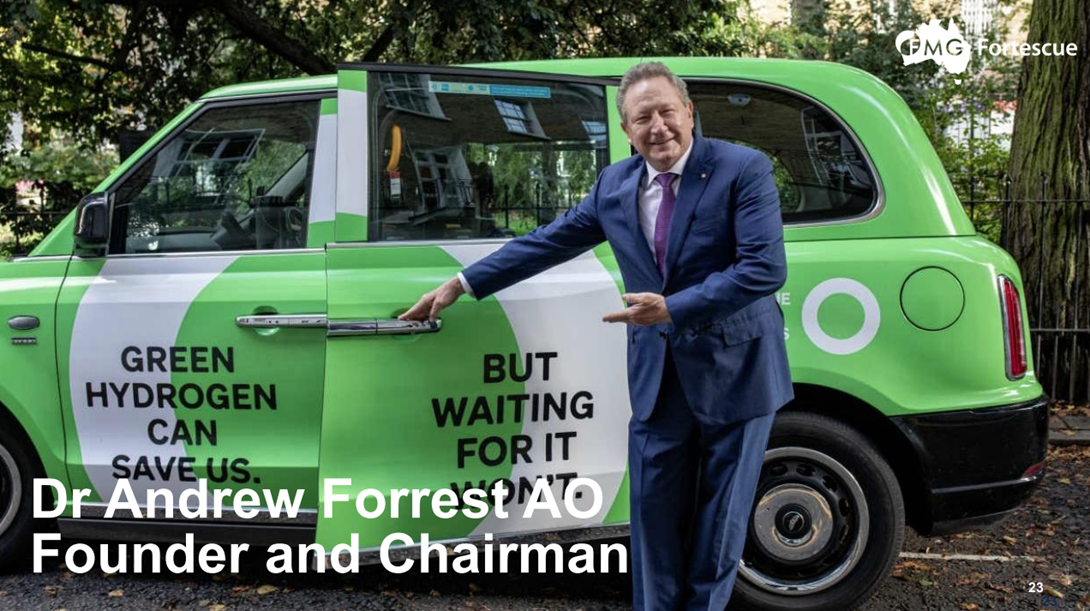
24-Jan-2022: Acquisition of UK Based Williams Advanced Engineering
ACQUISITION OF UK-BASED WILLIAMS ADVANCED ENGINEERING
Leading provider of high-performance battery and electrification technologies Fortescue Metals Group Ltd (Fortescue, ASX: FMG), has entered into a share sale and purchase agreement to acquire 100 per cent of Williams Advanced Engineering Limited (WAE) from private equity firm EMK Capital and Williams Grand Prix Engineering Limited for £164 million (approximately US$223 million). The transaction is expected to conclude by the end of March 2022, subject to the satisfaction of customary conditions precedent including United Kingdom foreign investment approval.
WAE will be vertically integrated into Fortescue’s diversified resources and green energy business and will be managed via Fortescue Future Industries (FFI), Fortescue’s green energy and green technology division. Fortescue has worked closely with WAE since early 2021 to design and build a prototype battery system to power an electric mining haul truck, an important first step in the decarbonisation of Fortescue's mining haul fleet.
The acquisition of WAE provides critical technology and expertise in high-performance battery systems and electrification and will enable Fortescue to accelerate and support the decarbonisation of Fortescue’s mining operations as well as establishing an important new business growth opportunity. Together, Fortescue and WAE will develop battery electric solutions for Fortescue’s rail, mobile haul fleet and other heavy mining equipment, to accelerate the rapid abatement of diesel usage to achieve the decarbonisation of Fortescue’s mining operations by 2030. In addition, Fortescue and WAE will work together to grow WAE’s world-leading green technology and engineering business.
One of the first major projects to be developed will be a world leading battery electric train concept. Fortescue and FFI will announce further details on this early in 2022.
--- end of excerpt ---
This is what I want to see. Steady progress with the FFI division of FMG. I like it.
Disclosure: I hold FMG shares both IRL and here.






22-July-2021: The following image is a screenshot from a LinkedIn profile and Activity Feed - see here for further details: https://strawman.com/forums/topic/5257
I've chosen to post it under FMG because FMG is Australia's highest profile pure-play Iron Ore company (BHP & RIO have other divisions), and it's about the value we attribute to a bar of iron.
18-Feb-2021: Iron Bridge Update plus Half Year Results to 31 December 2020 and Half Year Results Presentation and Half Yearly Report and Accounts
plus: https://www.australianmining.com.au/news/fortescue-to-slash-iron-bridge-activities-amid-review/
17-Feb-2021: https://www.australianmining.com.au/news/iron-bridge-takes-hit-in-fortescue-leadership-cull/
16-Feb-2021: https://www.fmgl.com.au/in-the-news/media-releases/2021/02/16/fortescue-leadership-changes-%E2%80%93-iron-bridge
The cost blowout with FMG's Iron Bridge Magnetite Project - now expected to cost at least US$3 billion vs. their original $US2.6 billion budget - was softened by Fortescue today delivering a record half financial year performance, with shipments, earning and cashflow surpassing any half year in the company’s history.
Fortescue shipped 90.7 million wet metric tonnes of iron ore during the period, up from 88.6 million wet metric tonnes in the first half of the 2020 financial year.
This puts it well on track to meet its increased financial year guidance of 178 to 182 million metric tonnes.
The company’s earnings before interest, taxes, depreciation and amoritisation (EBITDA) also increased by 57% compared with the prior period to $US6.6 billion and its revenue of $US9.3 billion was 44% higher than the first half of the 2020 financial year.
Fortescue attributes this to a 3% rise in iron ore sold to 90.2 million tonnes.
“Fortescue’s performance for the first half of FY21 has been outstanding, and we are very proud of the whole team who have delivered our best half year operating and financial results since the Company was established,” their CEO, Elizabeth Gaines said.
“Fortescue’s excellent operating performance and continued focus on capacity optimisation has supported an increase in financial year 2021 shipments guidance and against the backdrop of continued strength of the Australian dollar, we have revised our guidance for C1 costs (to $US13.50 to $US14 per wet metric tonne).”
Not a half bad profit margin when Iron Ore is trading at over US$160/tonne!
My personal view is that iron ore will come down when Brazil's Vale get back into full production, post-COVID, however FMG are certainly one of the best available exposures to the high iron ore price that Australia currently enjoys.
I'm not buying them up here at around $25, but I wish I'd bought them back in the first half of calendar 2020 when they were trading below $15.
Post a valuation or endorse another member's valuation.




